Australian
and international
exploratory
performance and
media arts
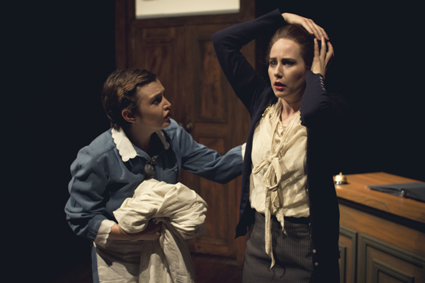
Tammy Weller, Anna Mowry, The Grand
photo Aaron Ashley
Tammy Weller, Anna Mowry, The Grand
The inaugural year of The Gold Coast Arts Centre’s intrepid Independent Season closed with the debut of Victoria Carless’ The Grand, produced by Gold Coast independent company, White Rabbit, led by director Lisa Smith.
Carless grew up in Cairns and won the Queensland Theatre Company George Landen Dann Award for her pro-refugee drama The Rainbow Dark in 2006. The Grand is a fascinating collaboration: regionally affiliated practitioners making a work about their respective tourist towns and the faded glamour and eerie nostalgia of an empty beachside resort.
The piece opens with a tremulous young woman (Tammy Weller) in a headscarf knocking on the imposing art deco double doors of The Grand Hotel. The door is answered by the imposing owner (Anna Mowry), who rejects the woman’s entreaties for work: it is the off-season, times are hard and guests are scarce. The young woman persists, wheedling her way inside, saying her mother worked there in its heyday. The doors are flung open and the older woman ushers her new protégé inside the foyer of the once luxurious hotel.
The first part of the play is driven by the instruction of the young woman in the mysterious ways of The Grand, empty save one unseen guest and crumbling under the onslaught of nesting birds and dwindling supplies. Slowly we understand that there will be no guests. The brave gallantry of the two women is expressed through their dogged focus on the daily rituals of hospitality: washing the bed linen stained with blood, mixing cocktails with flamingo swizzle sticks, scrubbing the floors clean of bird shit and reverentially opening the guest book to scrutinise the non-existent bookings.
Carless has a beautiful turn of phrase and a distinctive theatrical voice, unhurried and mesmerising as she builds the relationship between the two women. Are they half-sisters? Is this an elaborate game between them or merely the fantasy of one woman dying slowly in a poisoned world?
Alas, the looping games do not build in intensity but simply repeat themselves without deconstruction or game-play, or the sly wit of an absurdist non-sequitur. The gentle beauty of the language never deepens into complexity or ambiguity and so the piece feels oddly a-thematic, without the promised insight into the hollowness of the pleasure-town or the consequence of environmental violation. The gothic cupboards never open. The mystery guest/ghost never appears. The blood-stained sheets do not presage a violent act. The poison weakens but does not kill and the status quo between the two women barely changes.
The play feels like a clock slowly losing time and one that finishes for no other reason than that the mechanism needs to be rewound. Indeed, the climax of the piece is a re-enactment of the opening scene but with the older woman playing the stranger, relying on repetition again rather than progression or interrogation to resolve the piece. It isn’t that there needs to be an answer to the gentle ominousness of the gothic tropes but more a feeling that there is a corker of a play here yet to be dug out.
Gold Coast Arts Centre Independent Theatre Season: White Rabbit Theatre Company, The Grand, writer Victoria Carless, director Lisa Smith, Space Theatre, Gold Coast, 14-23 Nov, 2013
RealTime issue #119 Feb-March 2014 pg. 37
© Kathryn Kelly; for permission to reproduce apply to realtime@realtimearts.net
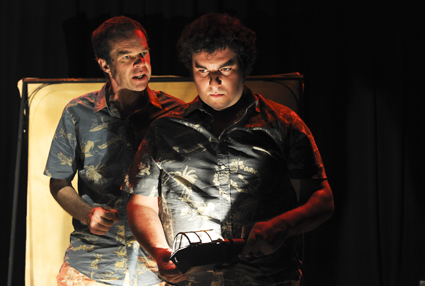
Anthony Weir, Michael Cutrupi, The Violent Outburst That Drew Me To You
photo Heidrun Löhr
Anthony Weir, Michael Cutrupi, The Violent Outburst That Drew Me To You
“He’s a little shit,” offers a 15-year-old audience member from Mount Druitt, in a succinct evaluation of the protagonist in the premiere production of The Violent Outburst That Drew Me To You. Writer Finegan Kruckemeyer beckons us to follow the journey of teenager Connor and his scattershot mind, joyously carried through by Michael Cutrupi with an explosive and determined energy that instantly endears him to the audience.
The first act kicks off at an unrelenting pace. Connor’s series of tantrums is cast as an overt symphony of pained interactions with a shape-shifting ensemble of cowed enablers and frustrated guardians, played by Kate Worsley, Emily Ayoub, Anthony Weir and Branden Christine with versatile buoyancy to match. In this lighter, but no less potent companion to Kruckemeyer’s Tough Beauty (RT117), director Kate Gaul’s dextrous assemblage of Connor’s outbursts invites us to the edge of his obliterating everything in his midst.
The boy’s reactions are authentic and lovingly crafted with a lyrical sprinkling of profanity. His sense of alienation and confusion viewing abstract artworks in the gallery while on a school excursion has a strange legitimacy when one considers the radicalising role of modern art in American ideological warfare.
The backyard theatre set mainly involves a wooden frame that functions as both shadow puppetry screen and partition for many an exchange, including annoying one of his mechanic Uncle Mal’s potential customers and, subsequently, landing some hard blows on his best mate. It is this that tests his parents’ patience and stretches our sympathy for him.
A bold scene sees Connor performing an extended and repetitive aria of the F-word, desperately trying to block out the sound of Stephen Fry’s voice, but also transforming the language in the ears of the young audience. Watching them squirm, settle and then hear profane language morph into poetic sound was more entertaining than concerning.
Scenes like these notably benefit from Daryl Wallis’ musical dramaturgy, lending Gaul and company a number of playful elements early in the production, for example Connor’s unseen classmate heckling in a rude bassoon baritone and his parents nagging in song. These are not merely clever devices, but point to Connor’s eventual coping strategy—to completely tune out.
Indeed, Kruckemeyer grants Connor and the audience of exasperated babysitters a well-deserved reprieve when his parents isolate him in his grandfather’s bush cabin. This Duke of Edinburgh Award challenge of sorts forces Connor to evaluate his behaviour. On the verge of delirious boredom, he crosses paths with Siena, a similarly troubled girl—played simultaneously by Ayoub, Christine and Worsley—who is more comfortable with the natural surroundings. Perhaps an apparition of dramatic convenience, this tomboy Artemis (Greek goddess, protector of young girls) both calms and links Connor to his hormonal awakening.
Directing his writing at a youth audience, Kruckemeyer has issued yet another unapologetic challenge to audiences to engage in a deeper understanding of the adolescent experience, that cuts across parental handwringing and legislative buck-passing over the perceived rise in unprovoked youth brutality on our streets.
True West Theatre, The Violent Outburst That Drew Me To You, writer Finegan Kruckemeyer, producer, director Kate Gaul, composer Daryl Wallis; Riverside Theatres, Parramatta, 21-30 Nov 2013; Griffin Independent, 18 June-12 July, 2014
RealTime issue #119 Feb-March 2014 pg. 38
© Teik-Kim Pok; for permission to reproduce apply to realtime@realtimearts.net
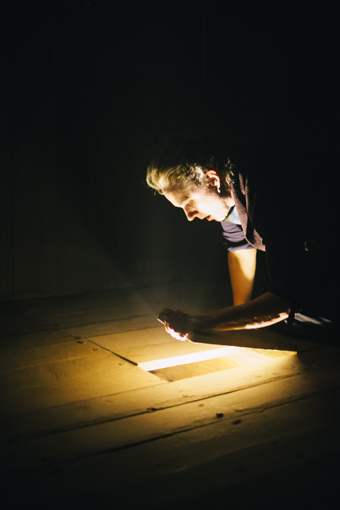
Jane Longhurst, The Green Room
photo Jesse John Hunniford
Jane Longhurst, The Green Room
It’s a rare hot day as I wade through the long grass on Hobart’s Queen’s Domain. The venue I’m ushered towards, the Victoria Gunpowder Magazine, is a place many Tasmanians have never seen, hidden as it is behind various sports grounds. Built in 1850 to house a mass of volatile weaponry—at its peak storing 1,000 barrels of gunpowder—the fortress-like edifice now appears neglected, surrounded by barbed wire fencing and accessed only on irregular tours by collectors of military memorabilia.
Inside this cold, virtual ruin, The Green Room, a site-specific production by solo-performer Jane Longhurst and sound artist Dylan Sheridan, is staged. This collaborative work is an outcome of the 2013 HyPe initiative, supported by Salamanca Arts Centre to encourage the creation of innovative, contemporary hybrid performance in Tasmania.
The fortress-like nature of the space seems more apparent on this day as the hot midday sun fades from view, the door is slammed shut and we are left in darkness. The marked difference in temperature somehow seems imperative, as this is an immersive work in which the audience is intimately connected to performer and to the space itself.
As we enter the room, Longhurst is already at work, sweeping the floor, stirring up dust. This sweeping—a recurring motif—is one of the ways the performer engages with the space, as tension builds around her choreography of physical gestures and interactions with a series of found objects such as rope and old gunpowder drums. In one suggestive sequence, a piece of rope falls to the floor which Longhurst then ties between two timber posts and swings on for a very long time, the rocking motion marked by the clocking sound of her boots against the floorboards. That I am disturbed by this—perhaps something to do with Longhurst’s proximity to the audience—says much about the potential of site-specific works to perturb common associations with a place.
The waiting game played with the audience is not only a test of endurance but also a sharp reminder of the site’s failed ideological function as a place awaiting a war that never came. This is alluded to in the work’s title, a Green Room being a space that accommodates performers when they’re not performing.
This preoccupation with the interstitial appears a central concern throughout the work, particularly in Sheridan’s exceptional use of atmospheric lighting and sound. With light glowing from the cracks between floorboards and hidden in crevices in the walls and a haunting soundscape ranging from a dull throbbing to metal scraping sounds—all of which were derived from field recordings at the site—the place takes on the guise of a character that taunts Longhurst. A point of brilliance is the performer’s response to a sound under the floor: floorboards are lifted, revealing a gentle, diffused light. This attention to the in-between and the duration of the interval creates a strange, resonant atmosphere where energy appears to seep through the very cracks of the building achieving a new and altogether more intriguing illumination of a hidden place and its stories.
As the work ended where it started—with sweeping—I was left with the impression that I was merely an interloper in a scene that would continue for the remainder of the day. The movement challenged and piqued its audience. With the room hazy from dust stirred, we emerged sneezing, stimulated by the textures of this strangely haunting place—and intoxicated by its smell and taste.
The Green Room, creator Jane Longhurst, Dylan Sheridan, performer Jane Longhurst, sound and lighting design Dylan Sheridan; Victoria Gunpowder Magazine, Hobart, 22 Nov-1 Dec, 2013
RealTime issue #119 Feb-March 2014 pg. 38
© Emily Bullock; for permission to reproduce apply to realtime@realtimearts.net
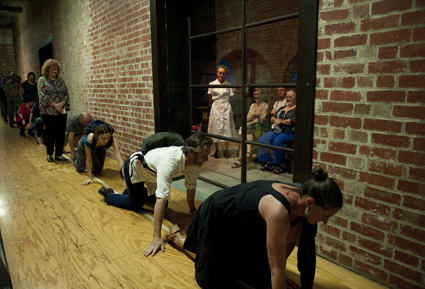
Waiting Room, Born in a Taxi
photo Paul Dunn
Waiting Room, Born in a Taxi
Strange things can happen while we’re waiting, beneath the spell of the cosmic joke, as Beckett showed us 60 years ago with Waiting for Godot. In the Waiting Room, Born in a Taxi’s reworking of their 2008 show, we are made to wait again in amusement and confusion, and for what, we don’t know.
The colossal Newport Substation, with its elaborate stairs and passageways, allows for plenty of play and delay from the moment of arrival. We all meet in the foyer and are issued a ‘waiting room’ number; the group is then split into three and ushered by separate routes—via devious detours—to the site of performance: a small room upstairs in the building’s rear. There is no defined performance space, only rows of chairs where we sit and watch the performers enter to sit in our midst one by one. We stare at them, and at each other. They stare at us. Until this air of addled anticipation gives rise to mischief of another kind.
In many ways, The Waiting Room is a study in the subtlety of non-verbal cues. The performers don’t speak, but compete and cavort with each other, trying to persuade us by gesture to physically join in the game. They play a forceful version of musical chairs, for example, but some of us are more willing than others to give up our seats. To what extent will we participate, or resist?
As audience, we rely on the custom of being led by our performers. We don’t hope to usurp them, perhaps only to join them at times. That’s why invitations to participate must be clear. The tricky, commendably radical, but not quite successful aspect of The Waiting Room is that the performers suggest an abandonment of traditional roles—a chance to get swept up in dancing, music, conga lines and the like—but there are no clear invitations. It is rather an experiment in generating atmosphere, and with a few exceptions (perhaps these people attended the previous show?) we remain suspended, disoriented and waiting for stronger cues.
Is this deliberate discomfort? The hint is there in a gentle, jocular way. As with Godot, the absence of narrative gives rise to malaise, which becomes the fuel for play and fanciful tangents. And as with Godot, social neurosis is exposed: hierarchy-complexes, tendencies toward calculation and competition, our reliance on permission and authority (be it God, Godot, the law or Big Brother). From time to time, a voice from the speakers prompts us, at one point inviting responses to major life questions: “If you’ve ever experienced the death of someone you love, lie down on the ground…If you are a critic or judgmental person, stand in the corner,” and so on.
This painful and playful candour does not divide us in the end, but rather unifies us through physical games, which shows that something is working well here. However chaotic The Waiting Room sometimes feels, its treatment of life’s anxieties is no mere abstraction to ponder at home. It is an immediate experience, set lightheartedly in a communal context: a limited window of time spent in transparent, bonhomous social unease.
Born in a Taxi, The Waiting Room, performers Penny Baron, Carolyn Hanna, Kate Hunter, Andrew Gray, Deborah Batton, Nick Papas; The Substation, Melbourne, 28 Nov-1 Dec, 2013
RealTime issue #119 Feb-March 2014 pg. 39
© Jessica Sabatini; for permission to reproduce apply to realtime@realtimearts.net
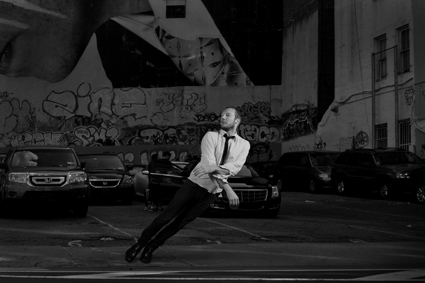
Stone/Castro, Blackout
image by Rodeo
Stone/Castro, Blackout
Death, paranoia and catastrophe define the 10-year-old body of work of Australian/Portuguese performance duo Stone/Castro. It is no accident the company formed two years after the September 11, 2001 terrorist attacks. Jo Stone, a Flinders University Drama Centre graduate, was in New York the day extremists toppled the great symbol of American economic power, the World Trade Centre.
Early in our interview Paulo Castro, Stone’s long-time collaborator and partner, confirms this darkly: “When the planes hit, Jo told me, people were looking up into the sky for more of them. Ghosts, sleepwalkers, somnambulists full of dust…”
The company’s latest production, Blackout, has as its point of departure not the specific events of that day, but the feelings of collapse and dislocation which suffuse the minutes, hours and days following cataclysmic events. Says Castro, “Blackout is about the state of loss of control, and about the cycle of building and destroying, destroying and building, that is the world in which we live; September 11, East Timor, the revolution in my own country…”
The revolution to which Castro refers is the 1974 military coup in Lisbon during which no shots were fired. The Estado Novo, Western Europe’s longest surviving authoritarian regime, collapsed, as peaceful protestors stuffed the gun barrels of soldiers’ rifles with cravos (red carnations). The post-revolution years were marked by democratising change and the dissolution of Portugal’s colonial empire, but Castro tells me the spirit of the revolution—of 25 April—penetrated deeply into the generation that grew up in its shadow. “We were all Pussy Riots,” says Castro of this time. “The theatre we were making in bunkers in Portugal in the 1990s was very political, anarchic and left-wing. It was a visceral and experimental world.”
Blackout, Castro tells me, will be less didactic: “It is a response to, not a play about 9/11. It will not be polemical in the way some of my earlier work was. We want to let people think.” Castro, by way of explanation, cites the work of German visual artist Gerhard Richter, whose 2005 painting, titled September, depicts the planes crashing into the World Trade Centre. Immediately searching online I find the painting is surprisingly small, but otherwise entirely characteristic of Richter’s work: photorealistic, but heavily distorted by the artist’s trademark ‘blur,’ an effect achieved by aggressively wiping a brush or sponge across the wet paintwork. Critic Robert Storr called September ‘anti-ideological,’ an attempt to decodify the imagery of 9/11 by disrupting the overfamiliar filmed and photographed representations of the towers’ collapse. It strikes me that Castro’s intentions with Blackout are analogous.
“More abstract that concrete, Blackout takes place on a metaphorical boat,” says Castro, “on which there is a catastrophic power failure. A wedding party is interrupted and suddenly the guests are exposed as frauds, people who all along had been pretending to be someone or something they were not.” Castro cites Lars von Trier’s 2011 apocalyptic drama Melancholia as an influence. That film, like Blackout, features a wedding that is disrupted by a catastrophic event, the narrative function of which is to interrogate extremities of human psychology rather than to anatomise disaster.
I ask Castro about the form Blackout will take, and he describes an approach that is fluid, multidisciplinary and improvisational: “We play within an extremely open space. In rehearsal with a combination of Australian and Portuguese dancers and actors we might attempt five versions of the same scene. Our work is a marriage of everything—choreography, theatre, visual image and soundscape.”
Aesthetically, according to the production’s press release, Blackout will use “blurriness and timewarp” in order to “take naturalistic scenes into a place that shifts between focus and distortion.” I pore over this sentence as Castro speaks, the connection between these words and Richter’s paintings clarifying. But before I’m able to raise the point, Castro obliquely confirms it: “Each moment is not exactly what you are seeing. As in a catastrophe, time seems to slow down and speed up in unexpected ways.” Neuroscientists, I discover later, refer to the phenomenon as ‘mind time,’ a cognitive reality generated by perhaps the most emblematic emotion of the post-9/11 era, fear.
The project is as provocative as any Stone/Castro has devised but Castro, in bringing our conversation to a close, says: “I’m not worried. I’ve worked in Sydney and Melbourne before, but Adelaide is a little bit special. It is a city thirsty for surprises.”
In addition to Jo Stone, the multinational cast includes Australian-based performers Vincent Crowley, Alisdair Macindoe, Nathan O’Keefe, Larissa McGowan and Stephen Sheehan, and from Portugal John Romao. Blackout’s key creatives include Portuguese lighting designer Daniel Worm and South Australian-based designers Sascha Budimski (sound) and Morag Cook (set and costumes).
2014 Adelaide Festival, Stone/Castro, Blackout, AC Arts Main Theatre, Adelaide, 3-9 March
RealTime issue #119 Feb-March 2014 pg. 40
© Ben Brooker; for permission to reproduce apply to realtime@realtimearts.net
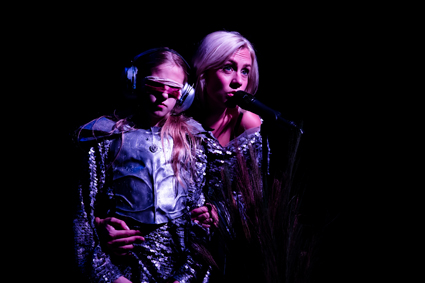
Bryony Kimmings and Taylor, Credible Likeable Superstar Role Model, photo courtesy the artist
One of the biggest challenges facing the organisers of the upcoming Festival of Live Art (FOLA) in Melbourne is defining the damned thing. Many of the artists in the festival don’t even use the term to describe their work, and those who do can’t seem to agree on what it really stands for. In other areas this might be a worrying matter, but when it comes to live art it suggests a festival which will be constantly questioning its own limits. It’s pretty exciting stuff.
“We began the whole process by getting a whole bunch of artists in a room and having a discussion about what live art is,” says Arts House Creative Producer Angharad Wynne-Jones. “And no one could agree. We tried to at least set some parameters about what it isn’t, and I think at one point we went well, it’s not a three-act play, and then even that was disputed.”
FOLA will be presented by Arts House, St Kilda’s Theatre Works and Footscray Community Arts Centre, the first time the three organisations have worked together. Given live art’s relative outsider status in Australia, it’s unlikely that such a festival could have been produced by one venue alone. The term was coined in the UK in the mid-1980s and the rise there of many bodies such as the Live Art Development Agency (LADA) has meant that a large community of art-makers has come together under the same banner. In Australia the scene is far more fragmented, isolated, but perhaps also more diverse as a result.
“It feels to me like the Australian artists engaged in that kind of practice have got a relationship with (UK live art) history and certainly they collaborate and connect internationally all the time, but they’re working in a broader context,” says Wynne-Jones. “There are connections into Asia that change the way we might think about live art, and within Indigenous Australia, things we might think about ritual and relationships to the body that are quite different to the UK context.”
FOLA works appearing at Arts House include Tristan Meecham’s large-scale Game Show, in which contestants vie for a prize pool consisting of every possession the artist owns; Sam Routledge and Martyn Coutts’ interactive drama set in a miniature railway and township; and Amy Spiers and Catherine Ryan’s Nothing to See Here, wherein Arts House patrons around the North Melbourne Town Hall and Meat Market will be dispersed, willingly or otherwise with “techniques police use to break up protests” (FOLA program).
The emergence of the festival was a serendipitous one for Theatre Works. Creative producer Daniel Clarke had already brought on live art practitioner Dan Koop to help develop a program named Encounters which would explore the possibilities of one-on-one and micro-audience performance. When talks about FOLA commenced, that program naturally wove itself into the larger festival. The Theatre Works season will include a work by choreographer Nat Cursio held in her own living room —there are only 10 tickets available for the entire season. Other works see audiences of one sharing a bed with cabaret artist Yana Alana, or investigating intimacy in the age of Skype with Melanie Jame Wolf, or else subjecting themselves to experiences of very real terror in Kelly Alexander, Jodie Ahrens and Melanie Hamilton’s Fright.
Fright stands out among the overall FOLA program, since much live art in Australia takes a generous, expansive or collaborative approach to audience-artist relations. Not that it’s all hugs and flowers, but it’s rare to find a work that delves into physically threatening territory.
“I did the development and I found it pretty full on,” says Clarke. “I was terrified at some moments, like physically afraid.” “It plays on a physical sense of fear,” says Koop, “an emotional sense of fear, a social sense of fear. In that same way that something that’s uncomfortable in a conversation can make you blush and laugh. It wasn’t all shrieking and pulling my hair out, there was awkwardness as fear as well. And self-exploration as fear, self-knowledge as fear.”
Theatre Works will also present performance artist Bryony Kimmings’ Credible Likeable Superstar Role Model, in which Kimmings and her nine-year-old niece Taylor develop a better icon for the contemporary tween. “There’s also a large part of Bryony’s work that doesn’t happen on the stage,” says Clarke. “This character that is the role model, Catherine Bennett, now goes out to schools and runs assemblies with tweens. She’s made pop songs, there’s a doco about her. The show is one part of this art project and it’s just sort of snowballing.” It’s an example of the way British live art occupies a broader space than the moment of presentation.
Melbourne-based performance maker and teacher Leisa Shelton is presenting an archive of Live Art Development Agency video during the festival as well as a work that seeks to “map” our memories of pivotal moments in Australian live art. Both Arts House-based investigations are attempts to rethink the idea of documentation in relation to a mode of art-making that is deeply concerned with the live moment.
Footscray Community Arts Centre’s CEO Jade Lillie is taking an equally interrogative approach to the festival. The venue is one grounded in community and socially engaged practices, and for some time she questioned how live art could contribute to these.
“For us it’s a playful way to look at what live art is in a community-engaged context,” she says. “We’re interested in questions like ‘who does a Festival of Live Art speak to?’ Sometimes my feeling is that live art practice often speaks to itself, or audiences that reflect the artist. I’m not particularly interested in that in our context.”
FCAC will host a forum addressing such questions as well as a masterclass with Lenine Bourke. Performance poet Alia Gabres will be recreating her grandmother’s traditional Eritrean coffee ceremony and both sharing and creating new stories live, and Triage Live Art Collective’s Strange Passions will see strangers swapping their own tales while rendered anonymous by masks.
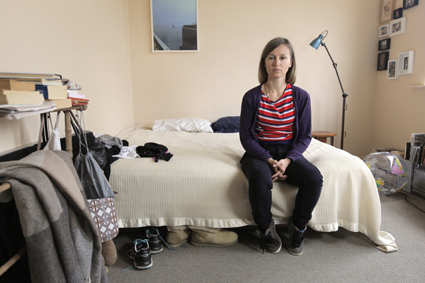
Beth Buchanan, I Know That I Am Not Dead
photo Andrew Sully
Beth Buchanan, I Know That I Am Not Dead
Appearing at Arts House will be post’s Mish Grigor, Paul Gazzola (artist, curator Temporary Democracies, RT117), James Berlyn (see RT118), Malcolm Whittaker, Emma Beech (RT115), Nicola Gunn with Triage Live Art Collective, Julie Vulcan (RT116), Jason Maling, Sarah Rodigari (ex-Panther), and Lois Weaver, independent artist for 25 years and lecturer in Contemporary Performance at Queen Mary University of London. Weaver is currently Artistic Director of the Air Project, an Arts Council of England-funded initiative that nurtures and sustains established Live Art practitioners and emerging artists in the UK.
Bryony Kimmings’ Credible Likeable Superstar Role Model will play at Theatre Works 25 March -6 April. EDs
Arts House, Theatre Works, Footscray Community Arts Centre, Festival of Live Art, 14-30 March
The full festival program is online at fola.com.au.
RealTime issue #119 Feb-March 2014 pg. 41
© John Bailey; for permission to reproduce apply to realtime@realtimearts.net
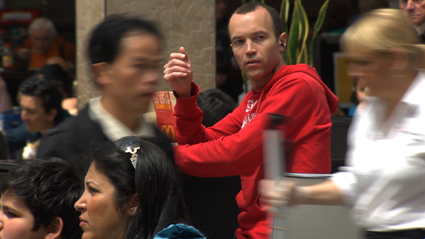
Tom Davies, PUBLIC
video still Tamara Saulwick;
Tom Davies, PUBLIC
I’m sitting, uncertain to begin with, wearing headphones; listening to fragments of conversations with no definite source. It takes a while—quite a while—to figure out who’s where; and often—usually—I can only locate one performer at a time. The other three are elusive, hidden amid the packed food court at Highpoint Shopping Centre in Melbourne’s inner west. It’s a Saturday afternoon before Christmas: the tiled hall overflows with fidgety kids, tired adults, stacks of shopping bags and pre-made food packs. The headphones mute the reverberating sound cloud of voices that floats between the punters and the atrium ceiling.
Over time, I relax into a humming, lulling soundscape, punctuated by random narratives and stray sentences: “Everybody’s checking each other out,” a voice says. But who, where? I just see shoppers forking up plates of stir-fry, playing with straws and phones. And then: a guy in a red t-shirt, moving reeeal slowly with a Macca’s bag and a Coke. He sits down nearby, his gestures continuing in exaggerated slow motion. The sounds of the paper bag, the crisp ‘tsss’ of snapped-open can are up-close in my ears. I can’t tell what’s ‘live’ or what’s recorded and performed in synch with the soundscape. There’s a disjunct, or perhaps an overlap, or even both: a jarring between what’s ‘out there’—the character, his movements, sounds—and what’s ‘in my head,’ pushed in there via the soundscape.
As PUBLIC unfolds, a second performer appears, strolling through the crowd—her headset mic is the giveaway. She talks about girls getting engaged; a guy on a late shift. The dance track “I Feel Love” is beating in my ears, anthemic and heady.
Another voiceover begins a meandering tale about an online encounter with a ‘chatbot.’ “You can meet him in a public room or you can tap someone and meet in a private room,” says the voice. Am I present here, or am I ‘lurking?’ Am I in a public or a private space; participant or voyeur?
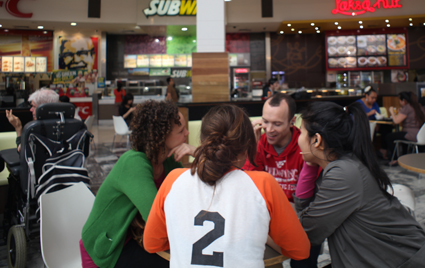
Rachael Dyson-McGregor, Nicola Gunn, Tom Davies, Diana Nguyen, PUBLIC
photo Tamara Kirby
Rachael Dyson-McGregor, Nicola Gunn, Tom Davies, Diana Nguyen, PUBLIC
PUBLIC extends Tamara Saulwick’s interest in ordinary speech and stories—as in Pindrop (see RT111) or her work in development, Endings. In PUBLIC, the scripted, performed text is just one element in the complex interplay of performer, ‘source’ and site. Whereas in Pindrop the stories themselves took thematic precedence, here the interest seems to lie as much, or more, in the shifting and often confounding merger between what’s staged and what’s already present in the space. Throughout PUBLIC I’m increasingly seduced by the way Saulwick, with sound designer Luke Smiles, elevates the rhythms of banal exchange to the level of music or poetry. I listen for the shifting timbres; the voices are melodic lines over an orchestral backing of eye- and ear-scapes.
As further narratives unfold and performers wander in and out of view, a feeling of real/unrealness grows. Who are all these ‘real’ people around me? Across the way, a woman playfully throws a screwed-up serviette at her child; a cleaner stagily pulls out a walkie-talkie amid the tables and speaks on it; a pair of elderly ladies on a bench seat look with interest around the court.
Hundreds of unpaid extras, in effect, flesh out an ambience that’s further illuminated when as audience we find ourselves eavesdropping on the four performers, who now sit together at a table, playing Truth or Dare. They confess fears and secrets. Behind them, two under-ten boys with mullets and blingy neck chains lick dripping icecreams and bemusedly look on.
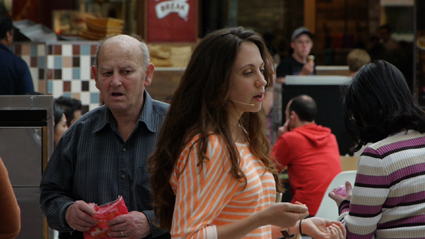
Nicola Gunn
video still Tamara Saulwick
Nicola Gunn
Site-specific performance, verbatim theatre and live art are all forms that increasingly draw our attention to ordinary life, shedding surprising light on familiar sites and activities. PUBLIC combines aspects of all three forms, intriguingly complicating and augmenting the food court space. At the same time—and despite some escalating performer actions that become gorgeously surreal—the work strikes me as almost ‘representational’—‘depicting’ the space, if you will, in larger-than-life tones, with the added resonant effect of my own presence in the picture. The work’s climax elevates, resounds, seeming to drift up into the cavernous ceiling to merge with the blue sky and fluffy clouds beyond the glass roof.
With the show over and my headphones returned, I sit back down in the food court and just watch, senses awakened to the sheer volume of people—seats occupied, vacated and immediately occupied again. Weirdly, as I prepare to leave, a man walks past me—really slowly—crumpling a Maccas’ bag…and he’s moving just slowly enough that I find myself expecting that crumpling sound, amplified and close-up to my ears.
Big West: PUBLIC, concept, direction Tamara Saulwick, sound design Luke Smiles, dramaturgy Martyn Coutts, system design Nick Roux, Highpoint Shopping Centre food court, Melbourne, 22 Nov –1 Dec 2013
RealTime issue #119 Feb-March 2014 pg. 42
© Urszula Dawkins; for permission to reproduce apply to realtime@realtimearts.net
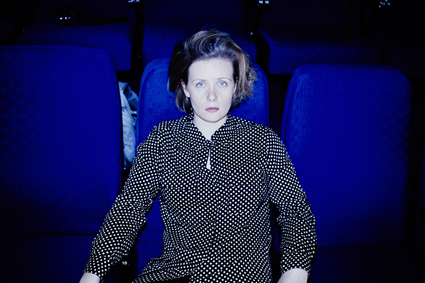
Sarah Giles
photo James Giles
Sarah Giles
Fresh from her success directing the opera double bill His Music Burns for the Sydney Chamber Opera in the 2014 Sydney Festival (see review), a radiantly cheerful Sarah Giles tells me she started young. At 15, with some fellow students she “directed a ludicrously ambitious production of Kafka’s The Trial, the Berkoff version. I fell in love with theatre.” With other successes, Marius von Mayenburg’s The Ugly One at Griffin and a much extended season of Mrs Warren’s Profession at the STC, where she has mostly directed, Giles is making her mark in Sydney theatre
She also cites key influences including Penelope Nunn at the South Yarra Ballet School—“an eclectic group of kids came out of there including dancer Alisdair Macindoe, actress Chloe Armstrong and my brother who’s now in fashion.” Giles went to Melbourne University, did an arts degree “and got involved with Union House Theatre and Susie Dee, a brilliant woman who continues to be an extraordinary inspiration for a lot of people.” She directed shows at university and then independent productions: “I acted in a show with White Whale Theatre with David Mence—brilliant, brilliant mind. He wrote a zombie schlock horror sequel to Macbeth that sounds bizarre but was fun and we took it to Edinburgh. I got back from that in 2007 and I’d decided I didn’t want to act, I wanted to direct. I think that was about control.
“I did some shows at La Mama and assistant directing with Peter Evans at the MTC. He was so generous with his time and with his insights. He was a real mentor and he’s developed into a friend over the years. So that was my first experience in a professional company and after that I auditioned for the NIDA Directors Course, got in and moved up here. This was in 2008 and I did the course with Egil Kipste who used to be the casting director at STC and had worked with Disney as well as with German director Peter Stein. We had the most wonderful chaotic year.”
At NIDA Giles directed Martin Crimp’s Fewer Emergencies and, for her graduation piece, The Bald Soprano: “I had fallen in love with the Absurdists when I saw a production of The Chairs with Paul Blackwell, Julie Forsythe and Marg Downie when I was 16 years old. It just seared into my brain. I was so proud of my Bald Soprano. I’ve never seen an audience laugh so hard. I’ve always loved comedies and been drawn to them. That really sealed my deal with comedy.”
After working with Red Stitch in Melbourne and for Griffin Independent a few years back she directed Matt Cameron’s Ruby Moon (2011) and in the same year Money Shots, both with STC’s Next Stage, and Mariage Blanc (2012), which she describes as, “a wonderfully inventive, completely mad Polish play by Tadeusz Rosewicz.” It was adapted by Giles and Melissa Bubnic, “a very funny writer from Melbourne who now lives in London. Then I directed Mrs Warren’s Profession in 2013.
“The common thread for me is exploring ideas through comedy. It’s not comedy for comedy’s sake. Comedy is one of the most powerful forms with which to explore almost anything.”
Giles’ comic sensibility was vividly evident in her direction of the first stage version of Gyorgy Kurtag’s …pas a pas … nulle part in His Music Burns (see p16). With the baritone Mitchell Riley (in a finely tuned performance at once funny, sad and despairing) and conductor Jack Symonds, Giles focused on “trying to get as close to the text as possible,” aided by how closely text and music work together in Kurtag’s score. She was also aware that the work “could be really heavy-handed and bleak.” I tell Giles that the production amplified that sense of being in the theatre, moments of boredom, of reflection, horror, terror. She concurs, “It’s like an illness. You’re trapped. You can’t get up and leave.” But we also laugh at the protagonist, and at ourselves.
I ask what attracts her to the plays of Marius von Mayenburg. His Eldorado was produced at Malthouse in 2006 and Moving Target in 2008, both directed by Benedict Andrews. “I spend a lot of time reading comedies and the minute I laugh out loud I know a play’s good. I read The Ugly One when I was at NIDA and it was the first play I’d ever read where I felt like someone had really hooked into a way of delivering a message to an audience not simply through what is said but how it’s said and the form in which it’s said. In Ionesco form and content all function together, but this was some of the first contemporary writing I’d read that was very funny and with a very bleak, very dry, very truthful sense of humour. A bit like Todd Solondz’ film Happiness. Another writer I’m in love with is David Gieselmann who wrote Mr Kolpert and The Pigeons.
“The other thing that drew me to The Ugly One was that I understood exactly what it was speaking about: the impossibility of being an individual within society. People sometimes think it’s a play about beauty and what we look like. That’s just the vehicle.
“I met Marius when he was visiting Sydney. We had a beer and he mentioned a play he’d written called Perplex. He sent me the English version. The first read was quite a fuzzy experience but it got more and more clear as I read it. I laughed out loud. It’s more cerebral but has more heart than The Ugly One. It’s a profound play. It moves me to tears. There’s a very beautiful ending. The thing I love about it is that it’s essentially about reality and what better form to explore that than through the theatre? [It’s roots are in] plays like Stoppard’s The Real Thing, to a certain extent The Maids and to a massive extent Pirandello’s Six Characters in Search of an Author. The premise is simply that none of us lives in a shared reality. My memory of this interview will be very different from yours. It’s something we don’t often think about and it’s evident in the disconnect [of being involved in] stupid things like Facebook and phones. People are not even in reality.”
Perplex is an extreme reality test for performers and audience. The press release from the Schaubühne (where the play was first produced directed by von Mayenburg before many productions across Europe) describes it as “like slipping on a metaphysical banana peel: …A couple, Eva and Robert, come home after a holiday. The plants look mysteriously different and a letter informs them of the disconnection of their electricity supply. Enter Judith and Sebastian, friends of the couple, who were meant to have taken care of things in their absence. However, they turn out to be the rightful occupants and throw Eva and Robert unceremoniously out of their home. A short while later they both return, but this time, after a change of outfit, they are an au-pair and the son of the second couple” (http://www.schaubuehne.de). But there is worse to come, and far more surreal. Giles is particularly taken by the existential power of the ending, where one of the characters asks, “Who cast me?” In von Mayenburg’s plays there’s a dramaturgical self-awareness in which the line between theatre and reality is a blur.
But strange as Perplex becomes, I ask Giles, does it need a surreal staging? She is adamant, “To pack a punch, you don’t want to blow the proverbial load of the play by having the people looking as if they’re bonkers from the word go. It’s about setting up an established reality for the audience to hook into and then allowing that to shift. They’re not going to walk in and see a deeply abstract avant-garde set from Renée Mulder, who’s resident here at the STC. We’ve worked together a lot.”
Expecting that Giles would be moving onto other productions after Perplex, I was surprised to hear that she’s entering a period of discovery with the help of the Mike Walsh and the Gloria Payten & Gloria Dawn Foundation Fellowships which will take her to Berlin’s Theatretreffen festival, Brussell’s KunstenFestivalDesArts and New York: “I’m just desperate to see a lot of theatre. Works of international significance do travel to festivals here but not often enough. We have one major opera company in the country. It’s not enough and many shows are not affordable. The only way to do it is to travel.”
Giles is also looking forward “to developing projects that I’ve been meaning to get to for a long time but I’ve not given myself time to do. I left NIDA five or six years ago and I’ve pretty much been working consistently. And it’s a lovely moment to pause for a second and just reassess. Without wanting to sound too serious, it feels like there might be a slight shift in my career. The little foray into opera was just so enlightening and there are so many I’d like to direct. It’s just got me. And I’m really interested in looking at other forms. I’ve got some mad ideas.”
Sydney Theatre Company, Perplex, writer Marius von Mayenburg, director Sarah Giles, 31 March-3 May
RealTime issue #119 Feb-March 2014 pg. 42
© Keith Gallasch; for permission to reproduce apply to realtime@realtimearts.net
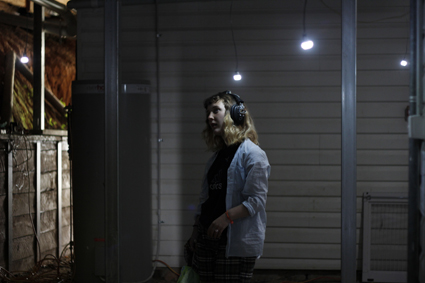
Photophon, Klaus Filip
photo Aksana Hugo Anastas
Photophon, Klaus Filip
Walking in single file through the inner passage of a dam is not where an audience for a music performance would usually find itself. Emerging from the other end onto the far shore of Lake Guy, deep in Victoria’s High Plains, was just as unexpected. Outside we were greeted by the drone of a hurdy-gurdy calling across the water and the spectacle of countless stars reflecting on the lake’s surface.
A bank of lights flashed intermittently further along the water’s edge, signalling a response to the music coming from the opposite shore. When the music ended the audience cheered and flashed their torches in the hope that John Billan, the artist responsible, would receive these signals of appreciation across the lake. A mobile phone call was made to Billan to request an encore, to which he complied and another five minute burst of haunting hurdy-gurdy wavered across the water. The sound was thrown across the lake by a ‘sound mirror,’ a large metal bowl standing on its side with a speaker in front of it.
This distinctive experience was part of Bogong ELECTRIC, an exhibition and performance program based around the Bogong Centre for Sound Culture. The Centre was established in the Bogong Alpine Village by sound artists Philip Samartzis and Madelynne Cornish to support cultural and artistic “initiatives investigating the history and ecology of the Australian Alps.” Following Bogong AIR in 2011 (RT102), this is the second festival associated with the Centre.
The village is an idyllic cluster of cabins fanned out on the side of the mountain alongside Victoria’s largest hydroelectric system, whose infrastructure includes a dam and several underground power stations. Rarely does such a pristine natural environment co-exist so closely with man-made industrial might. It’s hard to think of a more ideal setting for a posse of local and international sound artists to explore this juxtaposition across the festival’s four-day program through a variety of site-specific practices. Bogong’s relative remoteness also has its downside: over four hours’ drive from Melbourne, attendees were mostly the artists themselves and their partners, students of Samartzis or Billan, or others with some role in the festival, plus a few hardy punters.
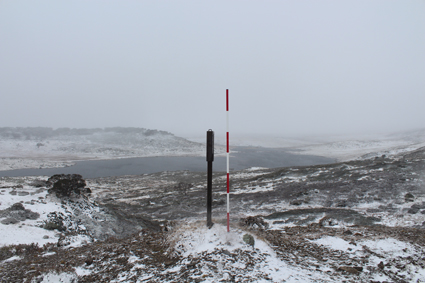
Geoff Robinson installation, image courtesy of the artist and Bogong Electric
The program was made up of a variety of performance and installation pieces situated around the village and hydroelectric infrastructure. The installations ranged from the familiar video/speaker set-up (Madelynne Cornish, Synchronator, Geoff Robinson), to unique works that required active participation from audiences enabled by the use of headphones. Christophe Charles’ piece was listened to while canoeing on the lake, and Lizzie Pogson’s work was similarly experienced walking through the innards of the dam, her narrative guiding the listener along the walkway. Klaus Filip’s simple yet delightful work invited participants to move through a series of suspended lights while wearing cordless headphones receiving transmissions from each light, ranging from electrostatic to music. Listeners often set the small suspended lights swinging to wondrous sonic and visual effect. The performances were often site-specific in nature as well, taking place outdoors, night and day, and even in the AGL Information Centre adjacent to the power station.
Themes of water, electricity and industrial sound (often sourced from field recordings made on location) recurred through installations and performances, but it was the artists who ventured a slightly different take from the obvious who were most successful. Billan’s piece was the outstanding work of the festival, largely because it went beyond these themes and explored the idea of signalling by both light and sound, using the lake and surrounding environs as a grand mise en scène that enhanced the evocative nature of the piece. Michael Vorfeld’s Light Bulb Music performance was also a (ahem) highlight. The Berlin-based artist’s multi-layered rhythms and textures created by an array of amplified light bulbs must have been close to top of the festival curators’ wish list when they settled on the event’s electricity theme. Vorfeld performed his piece lakeside in the evening, his blinking and buzzing coloured lightbulbs the only light source other than the stars. This was ‘electronic music’ at its most elemental.
The common criticism that sound art works are too long with little variation could be applied to most of the festival’s performances. Even Vorfeld was guilty of this to an extent; only John Billan’s sound mirror performance avoided this trap. The fact that he received an encore is a lesson for sound art performers. Yet there’s also no doubting that the more successful works of Bogong ELECTRIC lived up to sound art’s site specific aims of articulating both the space and environment. With its meeting of natural features and monolithic electrical infrastructure, Bogong itself was the star.
–
Bogong ELECTRIC 2013, curators Philip Samartzis, Madelynne Cornish, Bogong Village, 1 Nov-1 Dec
RealTime issue #119 Feb-March 2014 pg. 46
© Clinton Green; for permission to reproduce apply to realtime@realtimearts.net
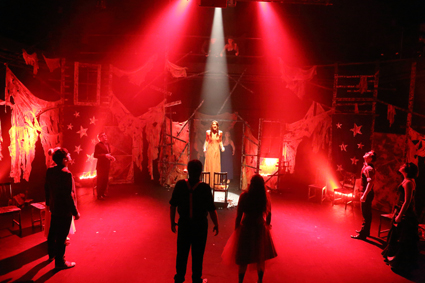
Hilary Cole and company, Carrie the Musical
photo courtesy Squabbalogic
Hilary Cole and company, Carrie the Musical
Opening last year at Sydney’s Reginald Theatre on a fittingly threatening night, the Australian premiere of Carrie the Musical emphasised humanity over horror spectacle.
Adapted from Stephen King’s seminal first novel about a teenage outcast with psychokinetic abilities, the musical began its life as an ostentatious Broadway flop in 1988. It has since been revised by original composer Michael Gore, lyricist Dean Pitchford and writer Lawrence D Cohen into a more intimate production which enjoyed a successful 2012 off-Broadway run before being realised for Australian audiences by Sydney independent music theatre company Squabbalogic.
Though taking a few wardrobe cues from Brian de Palma’s emblematic film version, Carrie the Musical is closer in tone to King’s novel, where the supernatural is undeniably present, but the main themes are repression, adolescent angst and cruelty. As befits the medium, this musical production has more light-hearted moments than both book and film, while retaining the story’s dark underpinnings. Thematically, as well as in its wise-cracking repartée and 50s-inflected song and dance numbers, this Carrie occupies the same essential territory as Hairspray and Grease, other narratives of teen outsiders striving to achieve romantic and social success on their own terms. With its small cast and orchestra tucked into the cosy confines of the Reginald, the intimate scale of Squabbalogic’s production was essential in making the audience feel an active part of this affecting performance.
The darkened set was a striking foil for Carrie’s romantic soaring ballads and the bright, often comedic group numbers. A derelict assemblage of charred chairs, wooden scaffolding and tattered fabric surrounding the semi-circular stage served to signify not only the heroine’s ultimate destructive act, but also represented the sackcloth and ashes ambience of Carrie’s home as well as the underlying rottenness of the school hierarchy.
The show begins with an interrogation. Isolated by a spotlight, wholesome Sue Snell has questions fired at her out of the darkness about the events of the fateful prom night of which she is the sole survivor. This scene will recur, forming a simple dramatic framing device for the flashbacks relating Carrie’s coming-of-age. Harnessing a powerful, clear voice to a fragile physicality, Hilary Cole brings a great deal of sympathetic intensity to the title role. As her nemesis, arrogant rich kid Chris Hargensen, Prudence Holloway injects the production’s one true note of evil, while Adèle Parkinson and Rob Johnson are likeable but not cloying as Sue and Tommy—the popular couple with a conscience.
It was somewhat disappointing to see Carrie’s relationship with her mother (Margi de Ferranti) considerably softened here. Perhaps in an attempt to avoid panto-style evil, Mama is a more sympathetic character than the sadistic religious fanatic in book and film, but this tends to diminish a key element in Carrie’s struggle. One of the film’s most effective moments is of course when Carrie stands crowned as prom queen, radiant with newly discovered beauty and social success—just before the spectacular drenching in pig’s blood. This scene will hang over any reworking of Carrie. The moment seemed rather rushed in this production, though its aftermath was visually arresting: Carrie’s devastating fury accentuated by livid red light and strobe flashes.
This tale of humiliation, paranormal ability, crushed hopes and mass murder would appear a challenging one to bring to the musical stage, yet director Jay James-Moody’s production had a surprising playfulness while never trivialising its central character’s very personal experience. It was great fun.
Squabbalogic, Carrie the Musical, director Jay James-Moody, composer Michael Gore, lyricist Dean Pitchford, writer Lawrence D Cohen, scenic designer Sean Minahan, lighting Mikey Rice, musical director Mark Chamberlain, choreographer Shondelle Pratt; Reginald Theatre, Seymour Centre, 13-30 Nov 2013
RealTime issue #119 Feb-March 2014 pg. 47
© Katerina Sakkas; for permission to reproduce apply to realtime@realtimearts.net
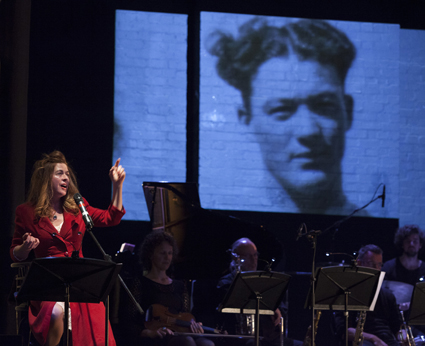
Max Sharam, The Hanging Of Jean Lee
photo Ponch Hawkes
Max Sharam, The Hanging Of Jean Lee
It’s hard to decide whether this collaboration between Andrée Greenwell, Jordie Albiston and Abe Pogos is a fantastical chimera or clambering Frankenstein’s monster. It’s certainly a thing of many parts that don’t always hang together, yet are often terrifically powerful in their own right.
It employs devices from a huge range of forms—documentary theatre, music theatre, mixed media, concert and installation—to relate the story of the last woman hanged in Australia. The combination of styles means that the narrative itself can slip from compelling investigative account to allusive poetry to the tawdry tackiness of TV’s Underbelly, even combining all three in the same instant. The video work, especially, which frequently re-enacts the unfolding drama, is surprisingly literal when juxtaposed with the richness of the score.
We certainly learn a lot. Jean Lee’s life from childhood to that final fatal fall is given a good canvassing, and the verse biography by Jordie Albiston from which the libretto is adapted (by both Albiston and Pogos) is a surprising combination of faithful biography and canny lyricism. Lee’s misadventures saw her falling into a world of prostitution and blackmail that culminated in the murder of an elderly bookmaker in the company of several other low-rent crims. The presentation of her downfall alternates between clinical coolness, moving pathos and garish fascination.
Greenwell’s compositions are an evocative almanac of genres, ranging from torch song to Eastern European-style jazz to Tin Pan Alley numbers. Hugo Race, Jeff Duff and Simon Maiden provide three very distinct and contrasting voices, with Race especially delivering the kind of dark and dirty textures that serve this bleak territory well. Max Sharam’s vocals are a fine fit as Lee’s resurrected stage self but the performer occasionally dropped lines during the Melbourne season, making it at times difficult to sense what the work should really be like in finished form.
It’s also difficult to know what the work’s makers themselves make of Jean Lee, who was executed in 1951. By almost entirely refraining from judgment of its central figure they limit the pity we might feel for Lee, or the horror at the murder of a maybe-but-maybe-not innocent. This may be deliberate, but the intent behind the work’s overall ambiguity is itself obscure. It may be that the concert setting is itself a potent alienation device, in the Brechtian sense, and the work never aims at the kind of realism that might dupe us into putting too much faith in the veracity of the tale’s telling.
But that distancing effect does allow us the space to relish what is a sophisticated and very enjoyable song cycle, several excellent performances and some writing of much merit. If any of it occurs at the expense of Jean Lee, at least there doesn’t seem to be anyone left who would care to defend her.
The Hanging Of Jean Lee, composer, image director Andrée Greenwell, libretto Jordie Albiston, Abe Pogos, audio Michael Hewes, lighting Neil Simpson’ Arts House, North Melbourne Town Hall, December 7-8
RealTime issue #119 Feb-March 2014 pg. 47
© John Bailey; for permission to reproduce apply to realtime@realtimearts.net
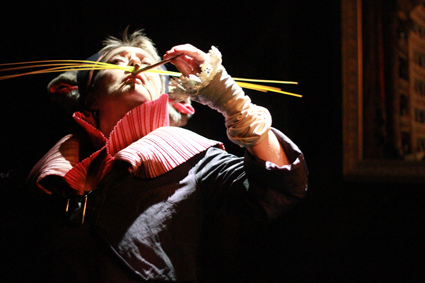
Margaret Cameron, Opera for a Small Mammal
photo Daisy Noyes
Margaret Cameron, Opera for a Small Mammal
At La Mama Theatre the audience competes for room with the modest set of Margaret Cameron’s one-woman play Opera for a Small Mammal. We crowd around the edge of the oversized tree-trunk cross-section serving as a stage. Extra seats are squeezed around a plush armchair and a toy piano with such tall legs that it can be played while standing.
Some, like myself, are familiar with Cameron’s work from her collaborations with David Young for Chamber Made Opera; others may have seen her first solo show, Things Calypso wanted to Say! in this same theatre in 1987. A woman dressed as a mouse enters “incognito” in dark shades and a scarf to announce that Regina Josefine del Mouse, the Mouse Queen whose dominion is “the lowercase letters of art,” will “issue a decree on the artistic nature of Matter.” We, “the Mouse People who live in the dark behind the scenes,” are all ears.
What follows may be understood through the literal translation of ‘opera’ as ‘works,’ each of the six scenes of Opera for a Small Mammal being a poem unto itself. Excerpts from Purcell’s The Fairy Queen break up the scenes in which Cameron sniffs, tastes and gorges her way through four centuries of theatre, philosophy, literature and music. The overall effect is a ‘philosophical theatre’ in the sense of the philosophical fiction of Umberto Eco or the philosophical autobiography of American writer and director Chris Kraus. Quotations lifted from Michel Foucault, Gertrude Stein and Hélène Cixous are cited with a footnote, that is, a receptionist’s bell on the floor that is struck with the foot. Alongside del Mouse’s voracious appetite for words are the retiring appetites of a bucolic character from an AA Milne story: a cup of tea, a good sit and a spot of sugar. What may sound like Wind in the Willows for theory nerds is a powerful meditation on the vulnerabilities and passions of the creative animal.
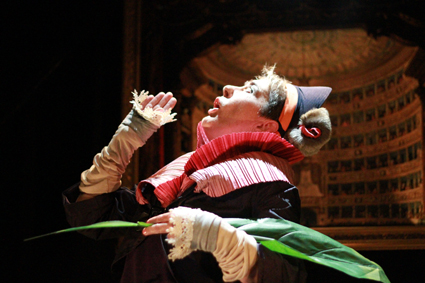
Margaret Cameron, Opera for a Small Mammal
photo Daisy Noyes
Margaret Cameron, Opera for a Small Mammal
Together, the six scenes describe an arc that will resonate at different points with different small mammals in the audience. A light-hearted encounter with the big Other (an elephant, to be precise) leads to a whimsical meditation on the libidinal economy of thought. Then almost without warning the audience is plunged into a free-fall of the soul, past grief and humiliation to land among the ruins of discarded identities. The sense of suffering at this point, as Cameron lies crushed under a weak white spotlight, is unbearable, her horror a cold hand on everyone’s heart.
From the depths of despair, del Mouse makes peace with the consolations of self-fashioning, of “piping” with her tiny, squeaky voice, of “lettering” and of “daubing.” These acts are explained at the toy piano under a single held note, as though music too were a type of writing through which we may “Proceed into a distance We Understand.” Del Mouse’s intellectual appetites have returned, but in a new light born of suffering.
And del Mouse’s appetites come back in force as she strikes out into “the Orchard of the World” to pick the fruit for “Words and Jam.” She carries a basket of books and lemons, gorging upon them as she goes. But what follows this celebration of the fruit of life is a solemn ceremony. Del Mouse, carrying a giant wooden phallus and a basket of electronic candles, defiantly gives her decree before finally leaving the audience holding flickering candles. Too often do we live in bad faith and “abnegate Our Throne” at the word-sniffing, -tasting and -piping head of our bodies. We “cry Victim to inheritance/ Rather than Heir and heiress to the Question of the Dimensionality of Our Being.” Though we may be humiliated by mortality, such abdication is the one true death.
Chamber Made Opera, Opera for a Small Mammal, writer, performer Margaret Cameron, director David Young, sound design, operation Jethro Woodward; La Mama, Melbourne, 4 Dec, 2013
RealTime issue #119 Feb-March 2014 pg. 48
© Matthew Lorenzon; for permission to reproduce apply to realtime@realtimearts.net
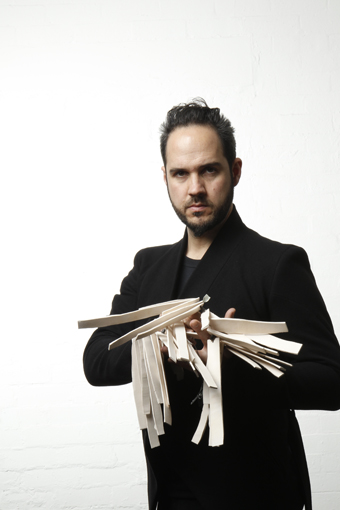
Eugene Ughetti
courtesy the artist
Eugene Ughetti
Over the past decade, percussionist Eugene Ughetti and his ensemble, Speak Percussion, have commissioned a startling catalogue of works by emerging and established Australian composers. As part of an MCA/Freedman Fellowship for Classical Music, Ughetti has brought these works together as a living portrait of Australian solo percussion music.
Ughetti’s portrait is virtuosic and post-experimental, which is to say that non-traditional percussion instruments and compositional techniques (with ‘traditional’ incorporating institutionalised techniques of the 20th century avant-garde like serial and spectral procedures) are incorporated seamlessly into unified compositions that are as rewarding to hear as they are challenging to play.
Alex Garsden’s Macrograph is a case in point. The variety of dinosaur sounds Ughetti conjures from a bowed cardboard box requires a mastery of diverse ricochet effects along the bow and extreme sensitivity to bow pressure and speed. These animal recitatives are held together by a background of irregularly chiming steel bowls containing vibrators that are turned on and off at switches as different tones are required. Despite the eclectic combination of instruments, the piece is a perfectly contained series of five episodes escalating in intensity, followed by a coda on pitch-pipes, styrofoam and a metal sheet.
James Rushford’s Twin Resistance requires an extensive battery of bells and crotales, including a series of chimes activated by mop-bucket pedals. The piece’s restricted tone colour provides an opportunity to focus on Rushford’s rhythmic world, a continuous tissue that defies repetition and meter.
While Garsden and Rushford’s pieces show Ughetti supporting a new generation of composers, the concert also highlights his relationships with established composers. Liza Lim’s ‘postcard piece,’ Love Letter, requires the performer to write a love letter and then translate the characters of the letter into musical material. Ughetti’s wife Rochelle must have felt very lucky listening to his beguiling daf drum solo. Throughout the letter’s eight sections (could they be sentences?), the drum is rapidly shaken, swayed, struck all over and caressed with hands, knees, loofah pads and a superball until the final gesture: three Xs traced on the drum skin with the fingertips.
Thomas Meadowcroft’s Plain Moving Landfill from 2003, the earliest work on the program, provided a contrast of pace. Two soporific foot bellows huff and puff into melodicas, generating a snoring, swelling drone. Meanwhile, Ughetti massages a bass drum with soft mallets, brushes and a plastic water bottle.
The concert ended with Anthony Pateras’ Hypnagogics “for microsounds and tape,” which draws in part on the psychoacoustic experiments of the composer Alvin Lucier. Thanks to Ughetti, listeners have had multiple opportunities to hear this work over the past eight years and explore its psychoacoustic properties in different settings. Throughout, Ughetti plays short bursts on rows of shot glasses, small ceramic teacups, miniature skin drums and crotales—the ‘microsounds’—which interact with tones from the tape part to create binaural beats, or tones that seem spatially and timbrally disconnected from the performer’s actions. In this performance I did not hear the ear-tickling binaural beats that I have before, but tones that seemed to fill the room with a shimmering aura.
After such a rich series of short performances, I can’t help asking where the neat edges of the works commissioned by Ughetti come from. What does it say about the funding and commissioning process in Australia that the radical sounds of the past 50 years are being packaged into neat dramatic arcs and discrete variations? Are composers writing for CDs and impatient audiences? Is there a genuine sense that the ideas explored therein need no more than 10 minutes to unfold? Ughetti’s portrait of Australian solo percussion music may also shed a light on the audiences and institutions surrounding it.
Eugene Ughetti, Australian Percussion Solos, Melbourne Recital Centre, 14 Dec, 2013
RealTime issue #119 Feb-March 2014 pg. 48
© Matthew Lorenzon; for permission to reproduce apply to realtime@realtimearts.net
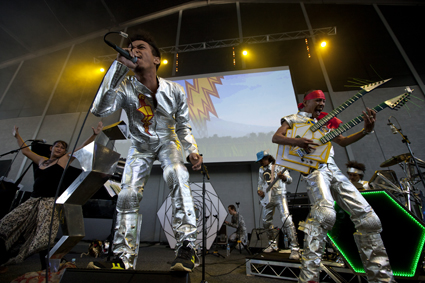
Slave Pianos/Punkasila
photo Rémi Chauvin, courtesy MONA Museum of Old and New Art
Slave Pianos/Punkasila
On the opening night of MOFO concerts at the MAC Precinct, young families, middle-aged couples and 20-something hipsters (never seen so many beards) lounge on pink bean bags gently nodding to the mannered drawl of Mick Harvey doing Serge Gainsborough covers.
Then we all troop to the Back Space to see Melbourne’s conceptual art group Slave Pianos collaborating with Indonesian art band Punkasila. Following this, Sun Ra Arkestra is wheeled out of cryogenesis to recall what free jazz used to sound like and the night is topped off with Astronautilus, a Florida rapper who’s on a career high because he didn’t expect a crowd this big and the view from the top of Mt Wellington blew his “freakin’ mind!”
Eclectic seems barely adequate to describe Brian Ritchie’s curatorial approach. While we’re told this happens overseas all the time, it really is unique for Australia, and I suspect it particularly works because it’s in Hobart. Present this combination of acts in a city that’s comparatively spoiled for choice and audiences might just be a bit too picky, waiting for the sideshow to see only the act they know and already love.
Schizosonics
It’s not just that the overall combination of acts is eclectic, some of the performances are seriously varied within themselves. Take the Slave Pianos/Punkasila collaboration. It opens with Australia’s most renowned pianist Michael Kieran Harvey performing a virtuosic haute-classical solo for around 10 minutes. Punkasila, in silver suits, stand around waiting, offering an occasional guitar buzz or a drum skiffle. Harvey finishes and they launch into 20 minutes of playful punk rock over which Indonesian singer Rachel Saraswati ululates. Projected above is an animation of the comic The Lepidopters in which it seems moth creatures from outer space come to earth and somehow everyone gets all sexy. While the Kieran Harvey solo sits oddly at the beginning, the symbolic weight of the Western canon and its imperialistic overtones is powerful. Somehow, by the end, it all seems to make its own kind of sense.
Similarly, mandolin player Chris Thile presented an almost bi-polar set of classical hits for the mandolin (played with astounding virtuosity but alarming facial expressions) mixed with hillbilly folk and a Fiona Apple cover for good measure. Driving the point home, his opening “song” consisted of a cycle of a few bars of each style in what was one of the most awkward, musically unsatisfying and yet somehow compelling openings I’ve experienced.
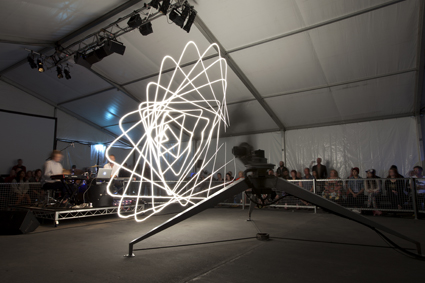
The Ada Project, Conrad Shawcross, (slow exposure exposing light tracing)
photo Rémi Chauvin, courtesy MONA Museum of Old and New Art
The Ada Project, Conrad Shawcross, (slow exposure exposing light tracing)
The A is for ART
This year’s major MOFO installation was by sculptor Conrad Shawcross. The ADA Project comprises a large re-purposed manufacturing robot with one articulated arm-like pointer, topped with a light globe. Shawcross has created robot “dances,” the light trajectory tracing figures visible only through long exposure photographs (light drawings). Along with curator Ken Farmer, he then commissioned four musical works inspired by the light figure and movement: a post Reichian-rock piece by Beatrice Dillon and Rupert Clervaux (UK); an acid-house pop paean by Tamara & Milo (UK); an operatic lament from Mira Calix (UK) performed by Teresa Duddy (Aus); and some sophisticated glitchy vocal electronica from Holly Herndon (US, the only piece not performed live). The music varied in its connection to the robot, some pieces clearly matching speed, direction changes, angularity, others working more thematically responding to the namesake of the work, Ada Lovelace, 19th century originator (with Charles Babbage) of the Difference Engine. It’s an impressive work of scale and Shawcross and Farmer have created a strong and neat curatorial package but it’s also slightly other than what you expect it to be. The amazing geometries of the light drawings in the photographs are not visible in real-time with the human eye. Instead there is a gap, not an uninteresting one, between what we are told we are seeing and the kinetic action we experience which encourages a more engaged listening.
Tyondai Braxton’s HIVE is billed as an “architectural installation,” which it may have been in its first instalment at the Guggenheim Museum in New York, but here it’s a concert—performers before us, seated on elegant custom- built pods made of lattice material which pulse and glow in gorgeous colours. The multi-movement composition is testament to the power of the click-track as three percussionists perform intricate synchronous rhythmic sequences while Braxton and another laptop conspirator wrap grand swathes of texture, tones and noise around it all. It’s a slick combination of electronics and acoustic percussion, perhaps more so as Braxton avoids the large gestures of big instruments prefering the more delicate palette of woodblocks and smaller drums. This creates a focus and specificity to the action and sound without sacrificing energy and drive.
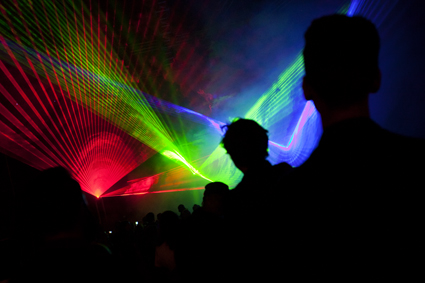
Robin Fox, RGB Laser
photo Rémi Chauvin, courtesy MONA Museum of Old and New Art
Robin Fox, RGB Laser
No MOFO is complete without a spectacle by Robin Fox who has performed at every festival so far. This year was particularly special as he was premiering his RGB Laser show. Fox’s green laser magic has awed crowds around the world in its own right and as part of Chunky Move’s Mortal Engine. It’s hard to imagine it getting any better but here the Fox has excelled himself. In a realtimetv video interview he explains that these new lasers (purchased courtesy of his Creative Australia Fellowship) have caused him to reverse his process. He used to drive the lasers with the music, now he creates the images first; these are then translated into sounds: fat, dirty, grunty, spitty and throbbing. Fox believes that the visuals make this noise-fest palatable to those less inclined to listen. While the audience is assaulted by noise they are also completely immersed in intersecting beams and cones of coloured light creating a psychedelic fantasia that enthrals.
But wait, there’s more
Outside of the MAC festival precinct was a series of concerts by the Australian Chamber Orchestra, the Australian Art Orchestra and the Tasmanian Symphony; a four hour mesmeric improv marathon by MURAL (Norway/Australia) with interactive visuals from Kjell Bjørgeengen at the beautifully dark and brooding Theatre Royal; and a subtle, ambient multiplayer installation by Melanie Herbert at CAT; and morning meditation gigs at the Baha’i Centre. A series of activities focused on the ecology of the River Derwent in the Heavy Metals Project at MONA proper. Other MONA exhibitions included the haunting Red Queen; a solo show by Hubert Duprat and his jewellery-making caddis flies; and the dark descent into madness that was photographer Roger Ballen’s mixed-media room installation Asylum, offering quiet, seeping terror. Oh and FAUX-MO, the after hours club that even sported a spaceship but filled with way too many teensters for this punter.
MOFO does of course also include relatively commercial acts (though always on the alternative end of the spectrum) like Matmos, The Orb and John Grant. While not everything satisfies there’s enough of ‘your’ thing to keep you hanging around, curious for the next instalment. This festival marked the end of the original matching funding agreement between MONA’s David Walsh and the state government. It was also the first time that interstate visitors hit 50% of the total audiences. Here’s hoping that the quality of the event and its audience impact is enough to renew funding arrangements so that this remarkable festival can continue to realise its bold and unique vision.
MONA FOMA, 15-19 Jan, MAC Precint, MONA and various venues in Hobart; www.mona.net.au/mona-foma
See video coverage including interviews with Colin Shawcross & Ken Farmer, Robin Fox and Russell Haswell, plus a bonus in-depth Fox interview.
RealTime issue #119 Feb-March 2014 pg. 49
© Gail Priest; for permission to reproduce apply to realtime@realtimearts.net
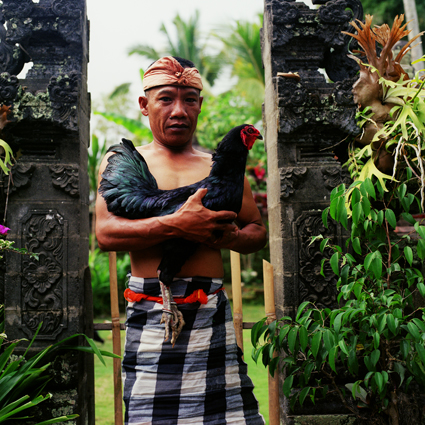
Emmanuel Angelikas, BUKA, Ketut and his prize cock, Ubud, 2005, courtesy the artist
Australia does not honour its artists sufficiently. For decades there has been an undeclared rejection of artists who do not fit neatly into a code or style. Emmanuel Angelikas is one of these. I congratulate the ACP on including him in their program and on their continued initiative to acknowledge photographers with a long-term exhibition history who have not received the attention they deserve.
Angelikas’ Buka was programmed by Kon Giourotis during his brief directorship of the ACP. However, the theatrical staging of Buka reflects the inheritance of its previous director Alasdair Foster. To walk into the dramatic atmosphere of the large exhibition space was to delight in an abundance of riches. The darkness embraced me and I was immediately entranced by the large photographic transfer onto bricks of an image of hands holding a Hindu ceremonial cloth called a poleng and a small votive representation of Christ on the cross. Next to this were quotations that combined to set the scene, including:
“The servants of the Beneficent God are they who walk on the earth in humbleness, and when the ignorant address them they say: Peace.” Koran 25.63
As a photographic artist Emmanuel Angelikas is an unusual mix of humility and defiance. Buka is a departure from his signature approach, which employs square black and white format, featuring portraiture and environment to explore individual personality (www.emmanuelangelikas.com.au).
Environmental portraiture in photography is typified by the work of Diane Arbus who was hugely influential in the mid-1970s. In Australia photographers such as Jon Lewis and Max Pam are well known examplars of this style. Pam and Angelikas were ‘partners in crime’, working on many shows together while supporting each other as practitioners.
Pam was the senior in this relationship that began when the artists met at art school in 1984. One subject they had in common was the eroticised Asian female. Since the 80s the stereotyping of the female body as erotic has been regarded as ideologically unsound which meant this work was regarded as problematic in some circles. Pam and Angelikas attracted the reputation of being ‘bad boys.’ The attraction to the Asian female body continues in Buka and some viewers might be uncomfortable with it but I don’t want to focus on this issue.
If we look at the history of Angelikas’ practice since the 1970s we discover a rich record of urban Sydney Greek culture. Born in Marrickville in 1963, where he still lives, he has responded to this archetypical yet unique multicultural Sydney suburb where sophisticated urbanity combines with traditional Greek culture. Perhaps Angelikas’ most iconic and memorable image is of a young Greek man sitting on a chair on the roof of a Marrickville house with a plane traversing the sky above him. This image, titled Person who would rather not be in Marrickville and made in 1985, perfectly captures the controversy raging at the time about the imposition of air traffic on urban Sydney.
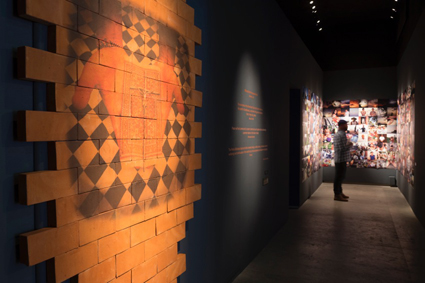
mmanuel Angelikas Buka, installation view, Australian Centre for Photography; courtesy and © ACP & Michael Waite
In the last 10 years Angelikas has had delicate health but accepted an invitation to Bali to document Balinese instruments in musical performances. As Max Pam says in his catalogue essay, “He loved the Balinese from the get go, and they loved him right back.” This led to many trips there between 2004 and 2011. He was introduced to the royal family and formed a fruitful friendship with Arya, a man who was a member of the royal staff. Bali provided Angelikas with the opportunity to heal. It also yielded an invaluable purpose, providing something that Marrickville did not although he was continuing to photograph there.
Seduced by the vibrancy of Balinese culture, in Buka Angelikas steps away from past practice and shoots colour. It is hard to put into words the magic of the environment created in this evocative exhibition. The staging and pools of lighting emphasize this by creating the atmosphere of a shrine, mirroring the importance of worship in Hindu culture and religion. For those who, like myself, have been to Bali there is no need for persuasion. For those who have not I can only hope they’re tempted to visit.
In the portraits, which make up the majority of the images, there is an intimacy, an openness that testifies to a special exchange between the Balinese people and the Australian photographer. Angelikas says this intimacy is revealed in the one to one photographs, looking into the eyes of his subjects. His special access to the royal family adds stylishness and a sense of occasion to other images.
There are hundreds of photographs constellated in clusters and single images of different sizes showing beautiful Balinese people of all ages, in traditional clothing, among verdant vegetation, in stone temples, under colourful sunset skies, groupings of young men wrapped in sarongs posing intently for the camera. In a grid of photos devoted to cock fighting a large central image features a man in a gateway proudly holding his black rooster for the camera. Circling the grid is a line of sharp spears that are attached to the ankle of the birds when they fight to the death.
The exhibition as immersive installation is its greatest strength. A wonderful component is the transfer of photographs onto the surface of traditional Balinese textures such as wood, bricks, silk, mother of pearl and bamboo. Angelikas did this with the help of artisans and technicians in both Bali and Australia. An image of a large orange and white carp in water is printed onto tiles and laid at an angle on the floor in the main room of the gallery. There is an image of shadow puppets on silk, a beautiful naked girl on mother of pearl and a man on snakeskin with a serpent curled around his neck. Individual images are framed with an ornate Balinese wooden frame (an image of what may be a royal couple with their children) or lined with traditional red and gold fabric (four young men naked to the waist in batik sarongs). Angelikas says of these masterful material transfers that “the photographs have been turned into objects, however at the end of the day they are still photographs.”
These elements bring us closer to an experience of being in Bali, a place and culture that has been historically over-romanticized, glamourised, terrorised and exploited. However it is a resilient and rich culture deserving of portrayal especially from the perspective of an Australian photographer. As I write this response to Buka in the warm weather of a Sydney summer I think I need a coconut and lychee cocktail and a gado gado. Then again, maybe I’ll go to Marrickville for a baklava and Turkish coffee. Congratulations Emmanuel Angelikas and may you be healed by Bali.
Emmanuel Angelikas, BUKA, curator Tony Nolan, assistant curators Claire Monneraye, Belinda Hungerford, Australian Centre for Photography, Sydney, 31 Aug-17 Nov, 2013
RealTime issue #119 Feb-March 2014 pg. 50-51
© Sandy Edwards; for permission to reproduce apply to realtime@realtimearts.net
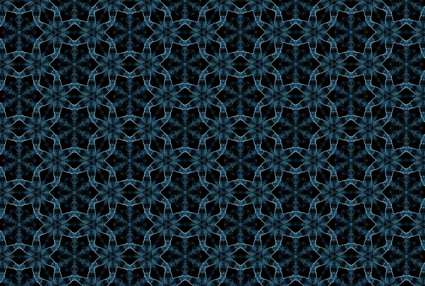
Dream Zone, digital compilation from screen, Karen Casey
courtesy the artist and Anna Pappas Gallery
Dream Zone, digital compilation from screen, Karen Casey
“Technology-based art has well and truly cemented itself in the cultural milieu,” writes hybrid artist Karen Casey. Aboriginal artists working with media technologies today create works that present a marriage of tradition and technology, a collusion of past and future in terms of techniques and aesthetic appearance. This was made clear back in 1984, when the first remote Aboriginal television broadcast came out of Yuendumu, 300km north-west of Alice Springs.
In the background of this broadcast was a painting by Andrew Japaljarri Spencer. Titled Satellite Dreaming (1984), it has a central planetary sphere out of which pathways branch to other spheres. It represents the desire for access to communications and broadcast technology, and specifically television, for remote communities. It is a visual picturing of how old media works, with a centralised hub that broadcasts content outward and it is seen on the very medium it pictures, yet it is created using ochre and paint, in dot style with symbolic iconography.
Jumping forward 30 years to another celestially-themed image, a lithographic print by Karen Casey becomes the content for a projection artwork created using technology at vast removes from analogue television. The print is titled Nebula, the current artwork, Dream Zone. Nebula became the visual data fed into a program for creating imagery using Casey’s brain waves. Dream Zone communicates different intentions from those of the Warlpiri in Yuendumu with their television broadcasts, yet it shares the same spirit in its desire to connect with others, in the quest for shared experience.
In 2004 Casey approached the Brain Sciences Institute at Swinburne University with the vision of getting data from her brain to use for the creation of artwork. At the same time she met her now key collaborator Harry Sokol. Since then Casey has created a series of works under the umbrella title of Global Mind Project, looking “at the idea, the possibility, the probability of the interconnected mind beyond the individual.” While originally from a painting and printmaking background, Casey maintains that in moving into media arts her ideas have remained consistent, but as she writes “digital technology has completely expanded my creative repertoire and given me the means to produce interactive and generative spaces and experiences that I was previously not able to realise.”
Dream Zone is a three-channel projection featuring an array of morphing, hexagonal-shaped mandalic forms. Like a soft breath the forms gently pulse in and out, all the while undulating in a seemingly infinitely complex and varied pattern to a background of ethereal music. Despite visual complexity the pattern is minimal, fading to black at times and leaving the viewer immersed in darkness for brief moments, until crystalline forms pierce through like star formations drawn from mysterious faraway galaxies. The colour palette ranges from inky blacks to icy blues and whites and, together with the forms, it appears as much at home among the minutiae of tropical waters as it does meandering through the cosmos.
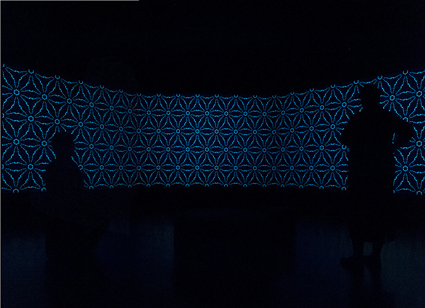
Karen Casey, Dream Zone, 2012, Generative video installation, National New Media Art Award, Queensland Art Gallery/Gallery of Modern Art, Brisbane. 2012
photo Ben Wickes
Karen Casey, Dream Zone, 2012, Generative video installation, National New Media Art Award, Queensland Art Gallery/Gallery of Modern Art, Brisbane. 2012
The Dreaming is so fundamental to Indigenous cosmology and art that I had to ask if this understanding had relevance for Dream Zone. Casey conceded to some relationship in that she proposes the possibility of “an association between an individual’s experience, or dreaming if you like, and that of others within the wider community.” More directly however, Casey’s use of the term ‘dream’ refers neurologically to theta brainwaves. “Theta waves are at the lower end of the frequency spectrum and when predominant they can be associated with dream states, creative improvisation and inspirational thought processes.” When viewed within the broader context of Aboriginal Dreaming Casey believes there is a relationship to theta mind-states. She writes, “It is in those instances when you totally lose yourself in the moment that you can transcend the temporal experience and access a kind of timeless continuum.” Indigenous temporality is ambiguous, ever-present and repeatable, as against historical time, which is linear, unrepeatable and future orientated. Sitting and watching Dream Zone is like being momentarily transported to a state of atemporality, beyond the task-driven noise of the everyday.
Neurologically, if the experience of art creates a pleasurable zing in the brain, it is triggered by a synergy of sensual relations between you and a given thing/object. Dream Zone is created via feedback with Casey’s own brain. She meditated on the morphing hexagon kaleidoscope while her brain waves were recorded and fed back into the program—she created the electroencephalographic feed for the work while she experienced it live. Ideally, the resulting imagery would stimulate a theta state in the viewer, “I anticipate viewers will experience a deeply meditative or trance-like state.” It is very enjoyable and relaxing to be in the presence of this work: staring into it does effect perception and takes you somewhere else. It is also quietly spiritual, on the topic of which Casey states, “…anything that can engender a feeling of connection with the world or make you feel like there is no difference between self and other sets the stage for what I think of as spiritual—there’s an empathy that comes out of that space but also a sense that the whole thing is dependent on consciousness. The consciousness I’m referring to is the interconnected totality of existence rather than simply an autonomous product of our physical being.”
Where else will this project be taken? How far will Casey push the question of the power of the collective mind and how much will she push the capabilities of the technology with her collaborator Sokol? The software developed by Sokol has a mind-boggling amount of aesthetic potential and there is certainly scope for the project to have more conceptual punch. Casey works from an “holistic perspective on life—of creativity, connection and community” and although Dream Zone trades heavily on the experiential, her background features strong projects with a social focus. By her own account Casey envisages an online scenario “where you can actually log in and have a neural conversation with someone else or a group of people.” However elusive it might be, the artistic potential of telepathy is a logical culmination of this exploration of the art of mind.
Dream Zone, generative video installation, artist Karen Casey, technical collaborator, software interface designer Harry Sokol, sound recording, compilation Tim Cole, media compositor, systems designer James Power; Fremantle Arts Centre, 23 Nov, 2013- 19 Jan, 2014
RealTime issue #119 Feb-March 2014 pg. 52
© Laetitia Wilson; for permission to reproduce apply to realtime@realtimearts.net
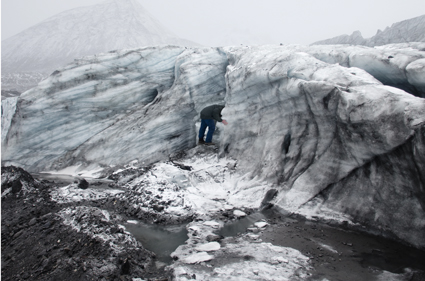
Expedition # 25, 2009, archival print from The Glacier Studies series—part of Singaporean artist Robert Zhau’s faux-scientific documentation of his expedition to the North Pole.
“Yellow Vest Syndrome” first caught my attention among Jasmin Stephens’ recent curatorial projects. A Western Australian phenomenon, Yellow Vest Syndrome sums up being able to do whatever the f… you want as long as you are wearing the requisite gear: the yellow vest, symbol of Big Mining, engineering, maintenance and whatever else is necessary to the smooth operations of the extractive industries.
Apparently WA locals have such respect for the yellow vest they leave its wearers unchallenged—as first tested by Melbourne artist George Egerton-Warburton, practising grafitti otherwise naked, on a main highway, in the bright light of day. Nobody stopped. Nobody questioned the yellow vest. WA is one of the big mining states, home of Gina Rinehart and Andrew Forrest. It’s where Gina’s employees were given standardised placards and paid to protest Rudd’s proposed mining tax increases. The Yellow Vest and its Syndrome are very much a part of the mining ecology—so naturalised in the landscape they’re taken for granted.
This earlier project, Yellow Vest Syndrome: recent West Australian art (Fremantle Arts Centre, 2009), was already, in part, a response to the notion of non-natural hybrid ecologies, the point being that originary or natural worlds and their so-called pure ecologies, reflective of a state of non-human intervention, are at best either extremely rare or a mythic ideal. Novel Ecologies Cross Arts Projects in Sydney’s Kings Cross takes as its starting point the idea that the actions of the human species are radically transforming notions of ecology. If ecology is an interrelated system of networks and webs of relationships among living things and elements on the planet (we tend to think of grass, sky, water and the animals on it as a living system), most of the world’s natural systems are now so compromised by the human presence that few ‘natural’ or ‘original’ ecosystems remain. Rather, we now inhabit a world of emerged and emergent, hybrid ecologies.
The recurrent theme of this exhibition is “ecosystemic thinking.” Perdita Phillips, artist-in-residence at Cross Art Projects, researched Sydney’s largely unknown fairy penguin colony at Manly, a population currently inhabiting a hybrid or breached ecology. Her work, penguin anticipatory archive, reveals a war zone as the penguins combat owners of expensive yachts. Ugly newspaper reports, sympathetic to bashed penguins, argue on the penguins’ side against the rich yachties’ perceived right to do what they want, flaunting their big money as they pollute and trample on the penguins’ habitat rights. Who would have thought? The penguins’ plight resonates as an allegory of local ecologies (farms, nature reserves, national parks) under the threat of big mining (Yellow Vest). How many Sydneysiders are aware of the fairy penguins and local ecology under threat?
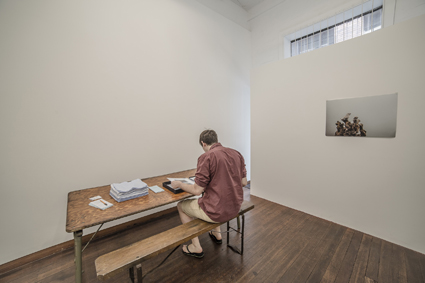
Perdita Phillips, , .–. / .- / .- (penguin anticipatory archive), 2013, mixed media, drawings and digital prints (work in progress)
courtesy the artist
Perdita Phillips, , .–. / .- / .- (penguin anticipatory archive), 2013, mixed media, drawings and digital prints (work in progress)
Viewers explore loose leaves in the archive box—poetic metaphysical meditations and drawings, photographs of penguins and Manly locations, harbour maps, representations of water and tides, scientific reports and descriptions of penguin life, newspaper clippings of shocking disturbances and maltreatment. To one side sits a pile of neatly stacked handkerchiefs which visitors are invited to take in exchange for signing a pledge to reflect on the penguins’ plight, opting to agree to one or more of the following:
“In exchange for a handkerchief I will: 1. ask “what does a penguin want?” and do something practical about it; 2, volunteer 3 days a year for a hands-on outdoor environmental project; 3. swap permanently from using tissues to using handkerchiefs; 4. other.”
This part of the work is titled “doing so that (tie a knot in it, the world is a handkerchief, a pile of promises).” The handkerchief gifts are embroidered in ‘penguin speech,’ an artistic envisioning of how penguins might negotiate this bargain—if they could.
In this respect Novel Ecologies shifts the emphasis from an anthropocentric worldview to one closer to Timothy Morton’s object-orientated ontology—non-human species and things. Philosophically, the shift can be traced to the reflections of Heidegger and Merleau-Ponty: “thing-being” (Heidegger) and the reversal of the gaze such that ‘things’ are looking back at us (Merleau-Ponty). On behalf of the penguins you are invited to shift your role from viewer-archivist to humble addressee and contract, through acceptance of the gift, to reflect on their plight. Relational aesthetics and its contract of gifting or exchange—Bourriaud’s famous remark: the artwork is a handshake—extends that contract to the world of non-human beings. It’s a cannily inclusive strategy within ecosystemic thinking.
Rounding out the show, the faked photographs of Robert Zhao Renhui/ The Institute of Critical Zoologists reflect on the hybrid state of so-called ecologies of the wild. George Egerton-Warburton’s video of pristine beach ecology is disrupted when a headset booming aggressive urban rap is donned. In the unlikely medium of fantastical fine charcoal drawings, Tori Benz puts the microscope on the rampant microbe ecologies inhabiting the surface and interior of the pregnant human form.
Cross Art Projects, Novel Ecologies, curator Jasmin Stephens, Sydney, 28 Sept-26 Oct, 2013
RealTime issue #119 Feb-March 2014 pg. 54
© Ann Finnegan; for permission to reproduce apply to realtime@realtimearts.net
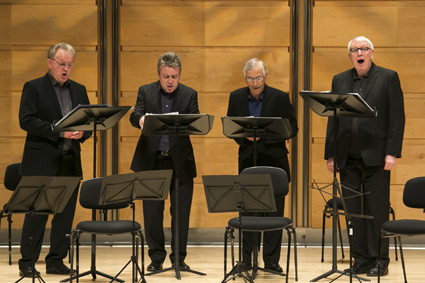
Hilliard Ensemble
photo Jamie Williams
Hilliard Ensemble
The Hilliard Ensemble
My first experience of a live performance by the UK’s The Hilliard Ensemble was a thrill: the singing felt and looked simply natural—lucid, warmly un-churchy, devoid of over articulation and forced projection in the responsive acoustic of the University of Sydney’s Great Hall.
I quickly became engrossed in the program’s blend of drama and reflection and the sacred and the secular, and a sense of discovery, not least the 13th century Viderunt Omnes by Perotin (rich in swelling wordless chanting, a contrasting jaunty performance of the text and a return to the mesmeric opening sounds), a set of traditional Armenian sacred songs (arranged by Komitas) seemingly in the Orthodox tradition but deeply infused with a distinctively local character (which is heard also as an influence in Marcus Whle’s score for Shaun Parker and Company’s dance work Am I), and three new folk-inspired songs by Hosokawa, which the ensemble only received on arrival in Australia. Linked by a humming motif, the songs slip organically between Western and Japanese modes with supple vocal glides, warbles and melodic twists out of folk, Bunraku and Kabuki traditions.
While the madrigals and liturgical pieces were predictably fine, revealing a great variety of forms and innovations, I was taken by the inherent theatricality of several of the works. Estonian Veljo Tormis’ Kullervo’s Message is a vigorously sung narrative taken from Finland’s Kalevala epic, hauntingly anchored with the repeated whispering of the hero’s name. Arvo Part’s And One of the Pharisees… and Most Holy Mother of God have a surprisingly intense theatricality when performed live. The latter is stunningly spare, solely repeating the phrase “Most Holy Mother of God, Save Us” 17 times with engrossing harmonic richness and subtle rhythmic variations making the prayer dramatically felt.
The concert’s encore was the very funny entr’acte about ‘nobodies’ (based on a Kafka story, Excursion to the Mountain) from a Heiner Goebbels’ music theatre work titled I went to the house but did not enter, in which the ensemble had become actor-singers in 2007—and clearly quite proudly so, if now apparently amused at getting through the piece. Sadly, this concert was one of the ensemble’s last—a founding member had been part of the group for 40 years, the others 20, making profound connections between musical traditions old and new, lustrously sung.
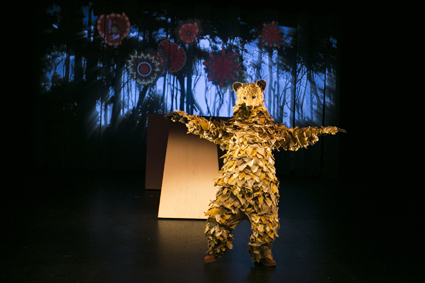
The Piper, My darling Patricia
photo Jamie Williams
The Piper, My darling Patricia
My Darling Patricia, The Piper
The common notion of tragedy is about lives cut short, especially those of children. The traditional tale of the Pied Piper of Hamelin entails the disappearance of all the children of a town, but the ambiguities provided by the variety of endings we have inherited make the tale more mysterious than tragic, if nonetheless inherently alarming.
My Darling Patricia’s The Piper, the first of two festival productions about the Pied Piper (the second was Sydney Camber Opera’s Into the Little Hill), presented an ambitious version of the tale apparently inspired by the Ted Hughes’ account. Although enthusiastically received by reviewers and audiences, I thought it over written and the narrative unnecessarily complicated. I was sometimes as nonplussed as the children of various ages around me.
Before the show proper commences, head-phoned child and adult volunteers respond to movement instructions familiarising themselves with the performing space. Once underway, they become the townspeople of Hamelin and the children are later lead away by the Piper. The story is told by an off-stage narrator (a reassuring velvet voiced Clare Grant) while large-scale projected animations by Sam James establish a sense of place (a heavily industrialised city, bug life close-ups of nature and surrounding conifer forests, although the narration slips in eucalypts as well). Unattractive white mobile ramps vary the stage space while deft puppeteering (later shared with the volunteer performers) provides humour in the form of the dextrous rats plaguing the city.
The Piper arrives: a glorious, autumnally golden bear—a she bear, says the narrator. First up, the non-speaking bear-cum-Piper amusingly mimes being a multi-instrumentalist, but that’s gotten quickly out of the way. Her talent is as a dancer: Ghenoa Gela moves with a delightful bear-like sway on hind feet. So what is going to seduce the children of Hamelin? The bear doesn’t pipe so is it the dancing? It’s a palpable gap and left me wondering. Could the pre-show ‘induction’ have included a simple dance step for the children, so when the bear dances them away it can be done with conviction in what should be a delightful but equally chilling moment. After all the Bear appears to seduce the rats in a dance with lengths of blue silk. In the meantime, the narrator has bewilderingly announced, If I hear right, that she is the otherwise non-speaking Bear/Piper.
The most bracing moments in The Piper include the Bear’s drowning of the rats, aided by the volunteers waving the blue silk cloth of the roaring river, and then her raging against the Mayor’s cheating her of her reward. She stands up high against a cloud swirling storm, gesturing angrily: nature intent on vengeance. After that, the children are taken away, eventually returning, partying with the bear, although the narrator is not so sure about their fate: maybe, she says, the children are “battling cane toads and other pests” with the bear. But what we see is of course more reassuring. There are many endings to the old tale: good (relocation to start a new life), bad (the Piper as plague) and ugly (the Piper as paedophile). This version is a muddle, lacking My Darling Patricia’s usual clarity of purpose and integrated design magic. The participatory goal and the appeal of the bear suggest that a more lucid Piper has potential.
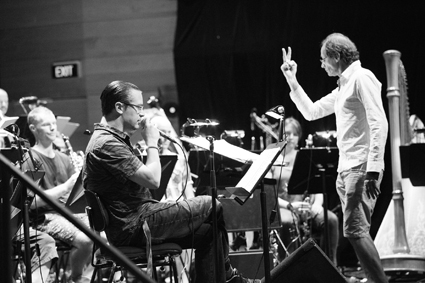
Ensemble Offspring with Lee Ranaldo and Mike Patton, Sydney Festival 2014
photo Chris Frape
Ensemble Offspring with Lee Ranaldo and Mike Patton, Sydney Festival 2014
Lee Renaldo, Mike Patton, Ensemble Offspring
In this double bill, Ensemble Offspring became a potent chamber orchestra, conducted with vigour and precision by Roland Peelman. Mike Patton, welcomed by a screaming audience, delivered his account of Berio’s Laborintus II with basso spoken and screamed texts with loudhailer and considerable verve, accompanied by the Song Company, its female member providing some of this fierce composition’s most beautiful, melancholy sounds in Part I, while the Ensemble Offspring orchestra excelled, especially in the quickfire transition to a demented big band uproar. Unfortunately there were no surtitles and a predictable rag bag of video images (forests, data map, speeding cars, experimental film scribbling) in Part II added nothing. But the interplay between the words of Dante, Sanguineti, Eliot, Pound and the Bible—as sound—with the acoustic instrumentation and electronic score was exhilarating and, in the end, gently seductive.
Also on the program was Lee Ranaldo’s Hurricane Transcriptions, a response to Hurricane Sandy (in its wake he had limited supplies and no electricity for a week). Although not intended as a literal recounting of being hit by a hurricane, the work nonetheless emerged from sharp cello snaps, whisperings and a deepening pulse into a subsequent musical storm in two waves, variously replete with electric guitar bowing and then chiming against frantic strings, siren moans and a hammered metal sheet. Unfortunately, the several songs that Renaldo wove into the work, while passable as stand-alones, sounded naïve, the accompaniment suddenly conventional and at odds with the rest of the composition’s ambient fascination. Nonetheless this moody, sometimes quite disturbing work made its mark in what was a standout festival concert.
–
2014 Sydney Festival: The Hilliard Ensemble: A Hilliard Songbook, The Great Hall, University of Sydney, 15 Jan 15; My Darling Patricia, The Piper, Carriageworks, 9-19 Jan; Hurricane Transcriptions/Laborintus II, Lee Ranaldo, Mike Patton, Ensemble Offspring, Song Company, City Recital Hall, 16 Jan
RealTime issue #119 Feb-March 2014 pg. web
© Keith Gallasch; for permission to reproduce apply to realtime@realtimearts.net
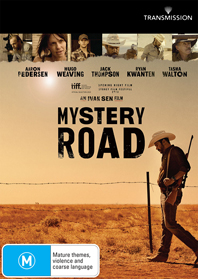
DVD: Mystery Road
Indigenous writer-director Ivan Sen’s award winning Beneath Clouds (2002) and Toomelah (2011) are followed by yet another distinctive feature film. “With its small-town setting, cowboy cops and a good guy in pursuit of justice, Mystery Road has more than a hint of the Western…Visually, it’s as clearly delineated as a graphic novel, displaying a predilection for close-ups and figures silhouetted against sunset landscapes…Sen has employed the framework of the whodunnit to create a striking piece of cinema whose stylisation enhances rather than overshadows this story about a misfit cop probing a town with a rotten, racist core” (Katerina Sakkas, RT116)
5 copies courtesy of Transmission Films
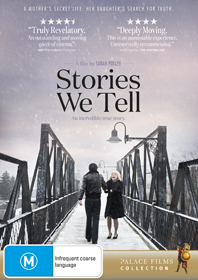
DVD: Sarah Polley, Stories We Tell
Canadian filmmaker Sarah Polley turns to documentary to examine the mysteries of her late actor mother’s life, using her father’s home movie footage and recreations in the same style that sync beautifully. Polley had always looked different from other family members, but beyond a bit of joking (characteristic of this clan) the truth does not come out until the director begins interviewing likely suspects and discovering their sometimes odd perspectives on the matter. Most engaging are her ‘interrogations’ of her father and his documented version of events. This is fine, un-melodramatic autobiographical filmmaking. KG
5 copies courtesy of Madman Entertainment
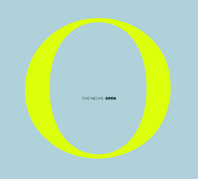
CD: The Necks, Open
“Open [is] a sparse work of bare percussion, tinkling chimes and gentle pianistic gesture…arranged in reference to a recording made by [drummer Tony] Buck of a Monochord, a droning stringed instrument tuned to one open pair of notes. “I’m not sure at what point we decided to start with the monochord,” says [pianist Chris] Abrahams. “We walked into the studio and the only thing we thought of was that we wanted to make something sparse…We didn’t want it to build too much, we wanted it to flow through a number of different scenes rather than a teleological build up of crescendos—that was the main brief” (Oliver Downes, interview with Chris Abrahams).
5 copies courtesy of The Necks
Please note you can nominate for ONLY ONE GIVEAWAY.
Email us at giveaways@realtimearts.net with your name, postal address and phone number.
Include ‘Giveaway’ and the name of the item in the subject line.
RealTime issue #119 Feb-March 2014 pg. 56
© RealTime ; for permission to reproduce apply to realtime@realtimearts.net
In Namakili, the first part of a double bill titled New Blak Territory, a lone woman in an Aboriginal design dress speaks in language. English words dot the dialogue and I struggle to understand what is being said. Immediately we are challenged by the boundaries between culture and race in Australia. Our orator provides an English translation and we discover her identity, her traditional country and her family roots.
We have begun a journey through the life of Namakili, “also known as Lynette.” Lynette Hubbard plays herself as the central character, her easy rapport quickly engaging the audience with emotional honesty, offering an intimate portrayal of the life of a Desert woman torn between two worlds.
The theme of black versus white is dominant: mixed race, cultures, heritage. In a hospital waiting room, Lynette is waiting for an appointment to see the doctor. Lupus (named in Latin after the wolf, she explains) is destroying healthy cells and affecting her kidneys. She muses that perhaps this is black waging a battle against white within her own body.
With dog howls, references to Tennant Creek artist Dion Beasley’s illustrations for the children’s book Too Many Cheeky Dogs and a fight between Lynette and her sister depicted as two dogs in battle, Lupus is never far from this story.
Peppered with humour, Lynette’s story-telling never shies away from the challenges and harsher realities of life. When confronted by another patient—“You’re not one of those tan people who think you’re black are you?…You’re either Aboriginal or you’re not!”—the dialogue shifts to Shylock’s “I am a Jew…” from Shakespeare’s Merchant of Venice before moving back into language, but accompanied by traditional Greek music, highlighting Lynette’s Greek heritage. The aggression, confusion, and tinge of tragedy in this scene is lightened by Lynette’s final quip to her fellow patient, “So you wanna be friends on Facebook?”
Namikili is unavoidably Northern Territorian in nature. The story touches on contemporary politics when one old patient jokes about installing pokies in hospital waiting rooms. “It’d fund the whole hospital system. (Northern Territory politician) Dave Tollner would do it.” Much of the strength of this work is in the close relationship the audience shares with the subject matter.
The performance is sporadically interrupted by a mobile phone, with Lynette having to explain to her family that she’s on stage at the moment and can’t talk. The phone rings one last time, and happy her work on stage is done she replies, “The show? I reckon it’s going alright.” Turning to the audience, she asks, “Whadda you reckon?” “Yes!” replies the audience before breaking into a final chorus of laughter and cheers.
In I Am Man, tufts of spear grass break through the floor of the theatre’s entrance, which leads into a primeval forest, the air thick with powdery white dust. Muted lighting reveals a mystical scene of slender poles growing haphazardly, some with tribal markings, others with metal pins protruding. The night-time clicks and rattles of frogs, crickets and other unknown creatures interject in this dark world.
Slowly a shadowy, grey creature emerges from the grass, wiping and blowing at the ground. He carefully takes straps from his clothing, marks his territory, then binds his hands with deliberate concentration. A twisting plume of dust appears from above and as the dancer is drawn closer he places his hands into the gentle flow of white powder. Sudden darkness falls.
A spotlight defines the naked torso of a man coated in white powder high at the rear of the stage. The dancer’s muscles ripple across his back as he rises from crouching. The sustained music with a sporadic bass drum beat and singers, Celtic in style, adds religious feeling to the birth of this creature.
Throughout there is a sense of discomfort. The choreography is lyrical yet abounds in jagged movements. The soundtrack’s deep beating pulse surges through me, while interruptions in the form of electric buzzing, clangs, a piercing whine and disembodied voices disturb and unsettle. At close quarters the two dancers are unsure of each other, tentative, frightened, drawn together by a curious uncertainty.
Breath and blowing are centrally thematic in I Am Man. Both dancers (Guy Simon, Darren Edwards) experiment with their breath, blowing into their hands, exhaling with force, discovering breath in their bodies. When the white creature collapses, his dark companion uses his breath to guide the other dancer’s movements, blowing him back to his refuge on the ledge above the stage.
The white powder provides both paint and canvas. The dancers create patterns in the heavy residue on the ground and smear the powder on their bodies. After a cleansing shower, the white creature writhes his wet body along the powder-coated wall leaving a faint image picked out by a spotlight’s beam.
In a final, distant duet with the white creature on his ledge and the dark one below at centre stage, the dancers mimic each other. The intensity of the choreography is expressed in considered, detailed movements; strength and agility are evident but the movement is also subtle and refined. A lyrical piano solo completes the mood of elegance in this duet.
As the light fades on the white dancer, the focus falls on the original shadowy figure as he delicately traces patterns, repeating them with his hands, head, body and feet. Audience members prop themselves forward in their seats, leaning in to the intimacy of the movement. The light dims, the dancer disappears, and we are left with the sound of a creature scuttering around somewhere in the dark. All too quickly this beautiful and reflective work has drawn to a close.
If Namakili and I Am Man are the beginnings of the New Blak in Northern Territory theatre, this is a trend I look forward to following. Perhaps they’ll be best enjoyed in their home setting and, like the iconic features of our local landscape, provide ample reason for audiences to travel to the Territory to experience them before we contemplate their national future.
New Blak Territory, a double bill of new Indigenous theatre, Namikili, writer, performer Lynette Hubbard, writer, director Stephen L Helper; I Am Man, creator, director Ben Graetz, performers Guy Simon, Darren Edwards, Brown's Mart Theatre, 19-30 Nov 2013.
RealTime issue #120 April-May 2014 pg. web
© Fiona Carter; for permission to reproduce apply to realtime@realtimearts.net
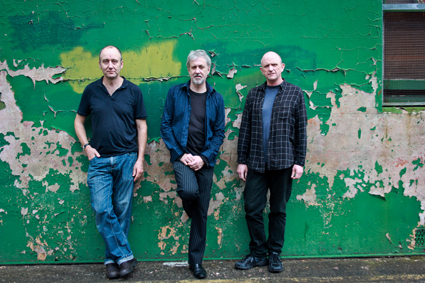
Lloyd Swanton, Tony Buck, Chris Abrahams, The Necks
photo Camille Walsh Photography
Lloyd Swanton, Tony Buck, Chris Abrahams, The Necks
Over a 25-year career of music making, The Necks have become renowned for live performances that leave audiences mesmerised and dazed. Although their simple, repetitive aesthetic seems to straddle the minimalism of Steve Reich and the lush musical narratives of groups such as The Cinematic Orchestra, as well as the rhythmic explorations of free jazz, the long-form improvisations that account for the majority of the trio’s work, while often quite tonal, tend to engage with a distinct set of preoccupations: the unfolding expressive possibilities of timbre and texture over extended stretches of time.
The group’s formation in the late 80s came about partly in reaction to what pianist Chris Abrahams describes as the “modern jazz style [where] there’s a melody and everyone takes a solo and you’d impress the audience with your chops.” Although all three musicians have continued to pursue other musical interests, whether with jazz luminaries The catholics (bassist Lloyd Swanton), avant-industrial outfit Peril (drummer Tony Buck) or Abrahams’ solo and session work and collaborations with Melanie Oxley, The Necks, which has only ever existed part-time, has provided its three members with a contrasting vehicle to create a collective music in which “there was no leader, no ego…[rather] the three of us making a sound world together, [with] no piano solos, drum solos and not dazzling people with how great we were as individual musicians.”
From these principles has arisen a form of improvisation in which each member submits to the flow of music as it is created, listening intently to the others to allow the particular trajectory being sculpted to emerge. Abrahams’ idea of an ‘off-night’ is “when I’m [consciously] thinking of where the music should go…I’m not saying that our way is better, but the main thing [is] to let the music itself inform us as to what direction it’s going, as it’s being played. To enable the performer to also be an interactive listener, to use [our] interpretation [of the music] to continue the piece wherever it does go—and for that direction to be a result of the interaction between the three of us, the acoustic quality of the space, the acoustic qualities of the instruments, the PA and the context [in which] we find ourselves.”
This intense attention that the music seems to demand sometimes provokes “feelings of annoyance and frustration and anger” in first-time listeners, according to Abrahams, before they “relinquish [their] preconceptions as they realise that we mean to be doing what we’re doing. [People] tend to simplify things, likeness is thought of as being the same. And we [the band] tend to do this as well, hear the music as repeating the same thing; but of course we can’t be doing that because we’re not machines. Every small difference that we make is amplified by the power of three… I’ll be playing and hearing that a certain note on the piano is bouncing off the wall in a weird way. I won’t analyse it like that, I’ll just hear that suddenly the piano is sounding strange and that’s what I’ll go towards, the piece will go in the direction of that. The repetitious line of what we do, which I think enables listeners to get mesmerised, allows us to move the whole thing almost surreptitiously—I know there’s a movement towards something and that’s what makes it compelling.”
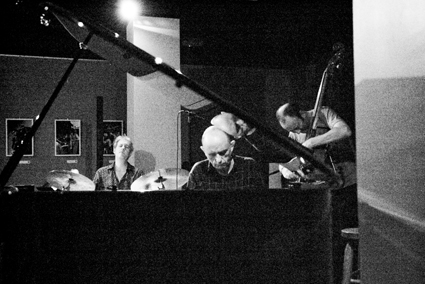
The Necks
photo John Tapia Urquiza
The Necks
This quality is readily apparent on their most recent recorded offering, Open, a sparse work of bare percussion, tinkling chimes and gentle pianistic gesture. Recorded over a 10-day period at Sydney’s 301 Studios, the material gathered in that time came to be arranged in reference to a recording made by Tony Buck of a monochord, a droning stringed instrument tuned to one open pair of notes. “I’m not sure at what point we decided to start with the monochord,” says Abrahams. “We walked into the studio and the only thing we thought of was that we wanted to make something sparse…We didn’t want it to build too much, we wanted it to flow through a number of different scenes rather than a teleological build-up of crescendos—that was the main brief.”
Open does indeed swell and contract over the course of its 68 minutes, providing in vivid terms what Abrahams calls an “abstract narrative.” The sitar-like rippling of the monochord is answered with harmonically static, yet richly expressive arpeggiated sevenths and pentatonic figures in the piano. At times the texture thins to a trickle, Buck dancing around a snare pattern that more implies than articulates a beat and Lloyd Swanton engaging in rhythmic dialogue with precisely placed single-note thrums. Then it expands into a rushing tributary, Buck building thick, shimmering fields of cymbal and gong over the sustained oscillations of Abrahams’ Hammond, before calming once more, the recurring motif of the monochord providing a foil and unifying device for the piece as a whole.
Although distinct from their live practice, in that motifs are rehearsed, over-dubbed and arranged in the mixing process, the recording is redolent with a fascination for the tactile possibilities of sound. “I think The Necks’ [music] is very physical,” says Abrahams. “The name comes into play there. The neck is almost this characterless functional thing—I’ve never alluded to what the name means and I don’t mean to suggest that that’s why we came up with it, but when you look back over the 25 years at the way the group has progressed, [you see] how like the music many things about the group are. The way we’ve gone about the ‘career,’ how we’ve had no organisation except to play concerts and how we’ve never really pushed things. We didn’t have a gameplan, we’ve never had a manager, we’ve never looked for more than what the next tour is going to be. That’s partly why the band is still together; everything is 33 and a third percent each, the compositions, the income from the gigs—we’ve just allowed things to happen as our pieces do.”
http://www.thenecks.com/
The Necks, Melbourne: 17-19 Feb, Corner Hotel; Newcastle: 20 Feb, Lizottes; Canberra: 22 Feb, Street Theatre; Sydney: 3 Mar, Sydney Opera House; www.thenecks.com
Courtesy of The Necks we have 5 copies of Open to giveaway.
This article first appeared as part of RT Profiler 1, 5 Feb, 2014
RealTime issue #119 Feb-March 2014 pg. 44
© Oliver Downes; for permission to reproduce apply to realtime@realtimearts.net






































